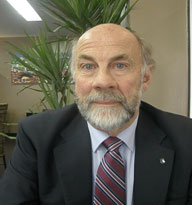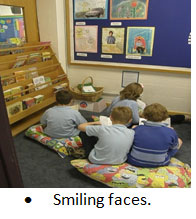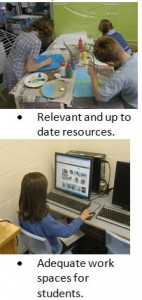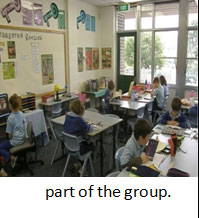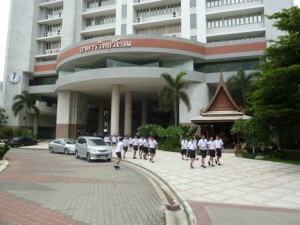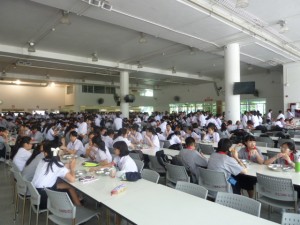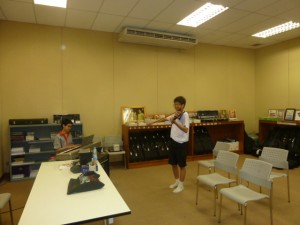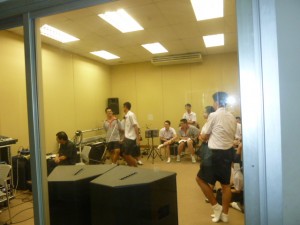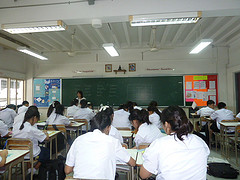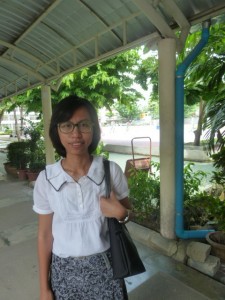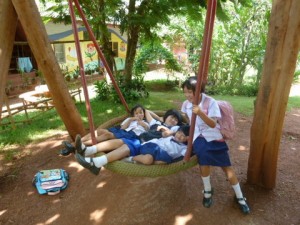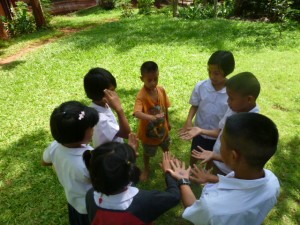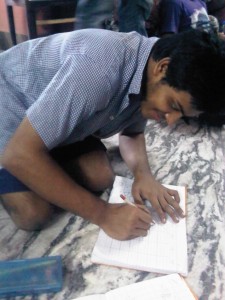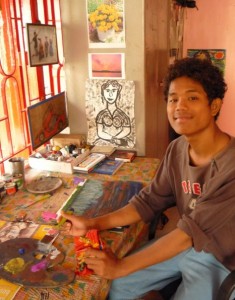OUR FEATURE ARTICLE FOR JULY 2011:
STUDENT-CENTERED LEARNING:
DEMYSTIFYING THE MYTH
Chutima Thamraksa

Teacher-centered or teacher-direct orientation has long been the focus of education in Thailand. This approach has placed an emphasis on rote learning or memorization rather than developing the thinking skills of learners. The drawback of the system is seen through the passive and dependent learners, who lack the skills to think critically and creatively. Recognizing this major drawback, the Ministry of Education has initiated a major reform of the system—from the traditional teacher-centered to a student-centered approach—with the intention of producing competent, independent and life-long learners who can keep pace with global competition. However, due to the several changes that have occurred as a result of the implementation of this student-centered approach, it leaves a number of teachers perplexed about their roles and the teaching pedagogy. This article attempts to unfold the puzzle by first giving a definition of the term and later on examining several aspects pertinent to the approach.
Introduction
The issue of student- or child-centered learning has been an explosion of interest among educators and school/college teachers in recent years. In fact, the term was not much recognized until the Thai National Education Act 1999 made it the key concept in the reform of education. This new approach, it is hoped, will maximize the potential of Thai people to cope with the increasing demands of the knowledge based economy and the world of information and communication technology.
Even with this interest, however, there arises much confusion and mistrust of the pedagogical movement behind the new model. Some teachers view it as a threat to their long-time teacher-centered or teacher-front orientation, while some fear that the approach will lessen the significant role they play in class, i.e., as the importer of page 60 SLLT 2003 knowledge. Likewise, some students become sullen and hostile to this approach as can be seen from the remarks that were recently reported in the newspapers that “the child-centered approach is like ‘khwai’-centered approach.” Literally, the term ‘khwai’ in Thai refers to a large cow used to draw plows for farmers. When used in reference to people or ideas, it implies that the compared people or ideas are witless. By describing the child-centered approach as ‘khwai’-centered approach, it can be inferred that the approach is a disappointment; it does not help students to become smarter but rather impedes their progress. Such a criticism clearly reflects the failure, not of the approach per se, but of the teachers’ misinterpretation, misuse and abuse of the concept.
Despite a substantial body of literature on student-centered learning, the majority of teachers, it can be said, are still skeptical of whether the approach can really enhance student learning quality. Much worse, teachers are uncertain of how and what they should do to implement the approach. A number of questions regarding the feasibility, viability and applicability of this teaching model are raised widely in the teaching community. As such, this paper will attempt to clarify and analyze the principles and aspects of student-centered learning through the most frequently asked questions in terms of this issue.
What Is Student-centered Learning?
Simply put, student-centered learning is a model wherein students are placed in the core of the learning process. As such, students’ needs, opinions, backgrounds, and goals are acknowledged and incorporated within the learning environment. In this model, teachers are guided by what is best for the students when helping them to learn or make decisions.
The concept of student-centered learning is derived from several models. It first evolves out of the constructivist learning theory which asserts that knowledge is constructed uniquely and individually in multiple ways (Vygotsky, 1978, cited in Bush & Saye, 2000). It also derives from the experiential model in which teaching is seen as transformation of existing knowledge (Kohonen, 1992) and the active learning model which suggests that all learning activities involve some kind of experience or some kind of dialog such as dialog with self and dialog with others (Fink, 2002).SLLT 2003 page 61
What Are the Characteristics of Student-Centered Learning?
On the basis of the models from which it derives, studentcenteredness entails these characteristics:
• The focus is on active learning, using an integrated approach to connect new learning to prior learning, stimulating interest and relevance, providing student choice and control, adapting to individual developmental differences, and providing a caring and supportive learning environment (Bansberg, 2003).
• Knowledge is constructed through authentic learning. It is learnt in a real context or the context in which it was first generated. In other words, it links school learning experiences to real world situations.
• Students are active participants in the learning process rather than passive recipients. They have opportunities and increased responsibilities to identify and self-direct their own learning needs, locate learning resources, and construct their own knowledge based on those needs.
• Class activities and project work are arranged differently to allow learners a variety of choices to select according to the needs of each student. This results from the notion that students have different capabilities and preferences for learning modes and strategies.
• A learning environment, where learning may take place anywhere, at any time, in many forms and by diverse means, is created. Such a learning environment enables students to be responsible for and involved in their education. As such, students are provided with substantive out-of-classroom activities that increase students’ learning in a number of dimensions.
• Students are motivated more intrinsically (self-motivation) than extrinsically (external motivation). Simply put, students are motivated from within not from without. For example, they type a written assignment because they take pride in their work not because they want people to admire or approve of it.page 62 SLLT 2003
Why Switch to this New Model?
What Is the Problem with the Traditional Method?
To answer these questions, we need to look back to analyze the nature of the traditional teacher-centered approach, and its outcome on learners to see why a student-centered approach should be promoted as an alternative.
The teacher-centered approach, influenced by the transmission model, affirms that knowledge is something that can be transmitted from teachers to students, like a two-dimensional learning of teacher to student instruction. In a classroom, a teacher is the person in authority whose job is to impart knowledge and skills, evaluate and correct the learners’ performance according to the criteria he/she has set. The students are relatively passive recipients of knowledge, and expect the teacher to be totally in charge of their learning.
As such, the typical pattern of classroom interaction in this transmission model is IRE—teacher Initiation, student Response, and teacher Evaluation (Mehan,1979). In the IRE pattern, teachers are always at the front of the room, providing knowledge, asking students to demonstrate knowledge previously taught, and evaluating the students’ responses and performance.
This teacher-centered practice is deeply rooted in Thai society, wherein “hierarchy” lies as a central value. Since Thais place an emphasis on the vertical respect relation and submission to authority (Williams, 1980), teachers, who have a much higher status than students, are regarded as the second parents whose mission is not only to impart knowledge but to teach morals and mold the students to be good citizens in society as well. The image that is generally assigned to a teacher is that of a “righteous guru” who possesses great knowledge. As such, it goes without saying that in the learning process, the teacher, not the learner, is placed right in the center.
In view of these two factors, the hierarchical pattern of society and the transmission model of education, we can understand more clearly why Thai teachers need to maintain their “righteous guru” image through the use of teacher-front orientation and the IRE pattern.
Unfortunately, however, such teaching practice has a major downside, for it has shaped learners to be passive recipients who merely listen, memorize, and absorb the information transferred by the guru rather than to initiate or negotiate the outcome of the learning process. Students are not trained to exercise their analytical, critical, and reflective thinking. Much worse, this education system does not (SLLT 2003 page 63) prompt students to become independent learners who recognize that knowledge is constructed in many ways, see the value of learning, realize that learning is a life-long process, and understand that there’s no one else but themselves be responsible for their own learning.
To keep abreast with the rapidly changing world of information and the economy that requires critical thinking, we need to empower the students. We need to enable them to think critically and independently, and be responsible for and involved in their learning. Students need to be self-directed and become active players in the academic learning enterprise. On all these accounts, it is time to advance from two-dimensional teacher-to-student instruction to three dimensional student-centered learning where students and teachers are involved in project work. According to Watanabe (1999), the latter can “allow for a depth in the learning process through the students and teachers active participation in the learning process—a participation that allows for an unlimited amount of creativity” (p. 1).
How Can Student-centered Learning be Implemented?
As mentioned earlier, the teacher-centered model has long been the focus of our education system. Therefore, in an attempt to implement the student-centered approach, the first thing that needs to be done is to re-conceptualize teaching and learning. The traditional concept—that emphasizes knowledge as the object to be transmitted, teaching as the presentation of knowledge, and learning as its absorption—must all be reformed. We need to implement a new conception that views knowledge as something that can be constructed, teaching as a means to provide an environment that is most conducive to learning, and learning as the process of learning how to learn. Based on the new concept, teachers and students need to modify their new roles to fit the learning process. These can be outlined as follows:
The Role of a Teacher
The teacher’s role, in a student-centered classroom, is much more crucial and valuable than that of the teacher-centered orientation.
Teachers need to:
• Change from the role of authority and presumed expert who possesses all knowledge to become a facilitator who provides apage 64 SLLT 2003 setting in which the students can play an active and inquiring role in their own learning.
• Create a learning environment that stimulates and challenges learners, fosters critical thinking and the process of knowledge construction. For example, teachers can enhance the thinking skills of learners through doing such activities as reasoning, decision making, reflecting, making inferences and problem solving. These types of activities encourage students to engage cognitively and emotionally with the learning tasks. The latter activity, especially, can be done by building an environment that allows students to examine complex problems using a wide variety of resources, develop their own strategies for addressing these problems, and present and negotiate solutions to these problems in a collaborative manner.
• Promote collaborative learning. Collaboration among students is an integral component of the student-centered approach. Working as a team, according to Kohonen (1992), can create a positive interdependence and individual accountability among learners as each member attempts to contribute to the team product and thus is in charge of helping his/her teammates to learn. Collaboration can also foster learners’ growth, develop social and learning skills, and help them construct their own knowledge through engaging in the exchange of ideas.
• Recognize the individual differences in approaches to learning. Teachers should set multiple tasks and give choices to learners to select and sequence their own activities independently.
• Reinforce the idea that the source of knowledge is not confined within the walls of a classroom, but may also be discovered outside. Some examples of sources of knowledge include: parents, elders, libraries, museums, historical sites, authentic materials, and the Internet.
• Utilize “authentic assessment” (“Authentic Assessment,” 2001)—one that examines a student’s collective abilities, criterion-referenced, and performance-based—rather than standardized assessment.
• Draw from different disciplines to integrate learning experiences and more importantly, use team teaching toSLLT 2003 page 65 achieve integrated learning outcomes. For example, teachers with different expertise like tourism and biology, working together, can bring together the concepts in different subjects to teach generally about the environment.
• Draw upon the relation between the students’ prior knowledge and experiences to the new learning. This is based on the notion that the learning experiences that relate to the students’ personal knowledge and experiences are the most easily learnt and often the most difficult to forget.
The Role of a Student
In a similar vein, students play a significant role in the learningprocess. They no longer view themselves as empty vessels waiting to be filled. Instead, they need to:
• Change from the old belief “knowledge is to be transmitted by teachers” to the new understanding “knowledge is to be constructed,” and be aware that students are responsible for constructing their own personal knowledge.
• Change from merely being passive recipients to taking part as active participants who are engaged in all aspects and activities of their learning (both cognitively and physically) that are generally the duty of the teacher in most traditional learning activities.
• Set meaningful goals for completing the learning activity, assume more responsibility for meeting those goals, and monitor their progress in order to determine if the strategies they are using to accomplish their goals are effective (Glassglow, 1997).
Is the Use of Technology an Integral Component in Student-Centered Learning?
There is no doubt that in the 21st century technology is increasingly important. Not only does it affect the way we live, the way we conduct business, the way we communicate with one another, but also the way we teach and learn. According to Tsang-Kosma (2003), the business world demands that schools prepare graduates who are skilled at working in teams, can effectively solve problems,page 66 SLLT 2003 are able to process and apply information, and more importantly, can use technology effectively in order to maximize productivity. As such, the challenges and educational goals for schools should focus on creating the learning environment that incorporates technology as well as fosters the skills necessary to empower students. If integrated properly, technology such as audio, dynamic visual formats, computers, and the Internet, will enrich the learning environment by using them effectively as a medium of instruction or a tool to enhance student learning. Some merits of technology, as outlined by NCREL (2003) are highlighted here:
• Technology can change the learning context from teachercentered to learner-centered activities, giving students more control of content, creating a more collaborative learning environment, and providing different ways of accessing information and communicating with people. Many interactive software programs can lend themselves well to learnercentered instructional approaches.
• Technology provides hands-on, minds-on activities—those that engage students’ physical as well as mental skills to solve problems. The activities can increase students’ fluency with given content, strengthen basic skills, help students acquire higher-level proficiencies, increase the relevancy of instruction to students’ lives, provide interactive feedback about their performance, and most of all, motivate students. For example, the use of electronic books, often on CD-ROM, can turn reading from a static, print-based activity into an exciting, interactive experience.
• Technology, particularly the Internet, is a tool well-suited to learning. It provides an ideal learning environment that allows anyone to learn by doing, to receive feedback, to refine understanding, to build new knowledge, and to reflect (“Preparing Tomorrow’s Teachers,” 2003). What Difficulties Can Arise in the Implementation of Student-Centered Learning? The difficulties that may arise from implementing this innovative model include: SLLT 2003 page 67
• Some teachers resist changing their old beliefs and usual teaching practices. Such resistance may occur from the deeply rooted “righteous guru” or “imparter of knowledge” image fixed in their head. These teachers view themselves as the authorities whose mission is to teach, direct, instruct, and control students. Therefore, they may fear doing things differently; they may see the change as a threat to their status and profession.
• A number of teachers are not willing to implement the approach, for they perceive that the way they teach is already the best and thus there is no need to change. Since these teachers opt to use only one way or method that they feel works best, they are not open to new ideas or other possibilities.
• Some teachers are in a rush to implement the approach without a thorough understanding of the principles and a careful plan of teaching. These teachers are too eager to make changes and do not take into consideration the culture and realities of their classroom situation.
• Some teachers lack the knowledge and skills to incorporate technology into their own teaching. Unfortunately, many teachers know very little about computers and are not interested in learning; while others may try to seek new uses for technology in the classroom but do not have sufficient technical support. These teachers see the value of technology but they feel frustrated because they are not trained to use these resources in the classroom setting.
• It may be the case that while many teachers are personally committed to serving students’ needs, the structure of their organization and policies may not accommodate or, in some cases, hinder the desire to be more student-centered.
• Some students reject the approach because they want evidence that they are being taught something. These students, like some teachers cling to the perception that knowledge must be transferred and thus wait for teachers to spoonfeed them.page 68 SLLT 2003
What Results Can be Indicative of Success in the Implementation of Student-Centered Approach?
The ultimate goal of student-centered learning is to produce self-directed, lifelong learners. This means that teaching can facilitate students to move from dependency toward autonomy. The success of the implementation of such an approach can be examined from the stages of student development below: (“Steps Toward,” 1996)
Stage One: Dependent Learners
Learners, at this very first stage, are dependent on teachers— authorities who impart knowledge, give explicit instructions on what to do, how and when to do it. To students, learning is teacher-centered. Students are not given an opportunity to make choices or exercise control over their learning.
Stage Two: Interested Learners
At this stage, learners show positive response toward the motivation and guidelines given by teachers. Despite a directive approach, teachers can successfully link content to students’ interests, show high support, and build a good rapport in the classroom community, all of which can reinforce student willingness and enthusiasm.
Stage Three: Involved Learners
Students, at this level, are much more developed. More and more, they see themselves as participants in their own learning, seeing the value of their own life experiences, and also the value of learning from and with others. Learners respond well to teaching through collaborative learning.
Stage Four: Self-directed Learners
At this stage, learners can set their own goals, plans, and standards. This gives them a sense of independence in, and responsibility for their learning. Teachers no longer give lectures, but rather act as consultants, monitor student progress, and give feedback in the learning process.
(SLLT 2003 page 69)
Conclusion
Student-centered learning is a model in which students are the focus of the learning process. This model, however, does not mean that teachers will step aside, letting students alone run everything. Rather, it means that teachers, when planning their teaching, will take into consideration the views and needs of students and run the classroom to the benefit of students. It also means that teachers will manage their teaching in a way that makes students feel included, value the educational process, and take control of their own learning.
Implementing a student-centered model is a true challenge for the 21 st century. The process of incorporating it into our education system demands hard work and effort from teachers and students alike. The key to the success of implementation requires, on the teacher’s part, a careful study and a thorough comprehension of the model’s principles, as well as a genuine recognition of its value. Through the new understanding, teachers then can change their old beliefs and practices; they can set the new goals and standards, and plan their teaching, taking into account what is best for students. In so doing, teachers can also work on their personal and professional development. On the learner’s part, likewise, students, guided by teachers, need to adopt a new conception of the learning process. They need to realize that if they are to keep pace with the rapidly changing world, and to compete in the global market place that has a growing demand for educated workers with skills in critical thinking, problem solving and decision making, they must change their long-time practice from passive to active learners. They need to empower themselves, gain control over their learning, and become autonomous learners. Finally, it is hoped, teachers and students working in collaboration, can gradually make the learning environment become productive and worthwhile.
References
Authentic assessment. (2001). Retrieved April 19, 2003, from
Home
Bansberg, B. (2003). Applying the learner-centered principles to the
special case of literacy. Theory into Practice, 42 (2), 142-147.
Bush, T., & Saye, J. (2000). Implementation and evaluation of a
student-centered learning unit: A case study. Educational
Technology, Research and Development, 48 (3), 79-91.
Fink, L. D. (2002). Active learning. Retrieved April 5, 2003, from
http://www.hcc.hawaii.edupage 70 SLLT 2003
Glassglow, N. (1997). New curriculum for new times: A guide to
student-centered, problem-based learning. Thousand Oaks, CA:
Corwin.
Kohonen, V. (1992). Experiential language learning: Second language
learning as cooperative learner education. In D. Nunan (Ed.),
Collaborative language learning and teaching (pp. 17-32).
Cambridge: Cambridge University Press.
Mehan, H. (1979). Learning lessons. Cambridge, MA: Harvard
University Press.
North Central Regional Educational Laboratory (NCREL). (2003).
Focus on student-centered learning/Support professional
development. Retrieved March 27, 2003, from
http://www.ncrel.org
Preparing tomorrow’s teachers to use technology. (2003). Retrieved
March 3, 2003 from http://www.pt3.org/technology/
tech_learning.html
Steps toward becoming a self-directed learner. (1996). The Teaching
Professor, 10 (4). Retrieved March 3, 2003 from
http://www.oaa.pdx.edu/CAE/FacultyFocus/spring96/excerpt.html
Tsang-Kosma, W. (2003). Student-centered learning + technology =
rethinking teachers’ education. Retrieved March 27, 2003, from
Georgia State University
Watanabe, Y. (1999). Second language literacy through studentcentered learning. The Internet TESL Journal, 5 (2). Retrieved
March 2, 2003 from http://iteslj.org/Articles/CaprioStudentCentered.html
Williams, D. L. (1980). Thai ways and my ways (Report No. SO
015980). Dekalb, IL: Northern Illinois University, Center for
Southeast Asian Studies. (ERIC Document Reproduction Service
No. ED 231183)
About the Author
Asst. Prof. Chutima Thamraksa obtained her Ph.D. in English
Rhetoric and Linguistics from Indiana University of Pennsylvania,
U.S.A. in 1997, M.A. in English for Non-Native Speakers and a
Certificate in Teaching English as a Second Language (TESL)from
Central Missouri State University, U.S.A. in 1988, and B.Ed. in
English from Chulalongkorn University in 1985. She is currently the
Chairperson of the English Department, School of Humanities,
Bangkok University. Her publications include three textbooks:
Exploring through Writing: An Advanced Rhetoric; Report Writing;SLLT 2003 page 71
Critical Reading, and articles on Virtual schooling: a technological and
educational revolution, and The use of ICT on language teaching.
*Chutima Thamraksa is an Assistant Professor and Director of the Bangkok Univeristy Language Institute
May 30th 2011
Student-Centered Learning: Demystifying the Myth

อาจารย์ชุติมา ธรรมรักษา
ครูเป็นศูนย์กลาง หรือ ครูเป็นหลักโดยตรงเป็นศูนย์กลางของการศึกษาประเทศไทยมาช้านาน แนวปฏิบัติดังกล่าวได้วางรากฐานการเรียนแบบตามบทเรียน หรือ การเรียนแบบจดจำ มากกว่าเรียนเพื่อพัฒนาทักษะการคิดของผู้เรียน ข้อบกพร่องของระบบดังกล่าว เห็นได้จากความไม่กระตือรือร้นของผู้เรียนที่ขาดทักษะการคิดเชิงวิเคราะห์ และไม่มีความคิดสร้างสรรค์ จากการตระหนักถึงข้อบกพร่องนี้ กระทรวงศึกษาธิการได้ริเริ่มการปฏิรูประบบการศึกษาครั้งสำคัญขึ้น จากรูปแบบที่ครูเป็นศูนย์กลางแบบดั้งเดิมสู่แนวทางการให้นักเรียนเป็นศูนย์ กลาง ด้วยมุ่งหวังจะผลิดผู้เรียนที่มีศักยภาพ มีสมรรถณะ มีความเป็นตัวของตัวเอง และสามารถเรียนรู้อย่างยั่งยืนได้ และจะสามารถยืนอยู่บนโลกแห่งการแข่งขันนี้ได้
อย่างไรก็ตาม การเปลี่ยนแปลงต่างๆ ที่เป็นผลมาจากการนำนโยบาย นักเรียนเป็นศูนย์กลางมาปฏิบัติใช้ ได้ทำให้คุณครูจำนวนไม่น้อยสับสบและงุนงงกับบทบาทและแนวทางการสอนของตนเอง บทความที่จะนำเสนอต่อไปนี้ต้องการที่จะสร้างความกระจ่าง ชี้แจงข้อสงสัยดังกล่าวโดยการให้นิยามและคำจำกัดความของแนวคิดต่างๆ และยังจะนำเสนอตัวอย่างจากแง่มุมต่างๆ ที่ตรงประเด็นกับแต่ละแนวคิดด้วย
บทนำ
ประเด็นเรื่อง นักเรียนเป็นศูนย์กลาง หรือผู้เรียนเป็นศูนย์กลาง ได้กลายเป็นที่สนใจของนักการศึกษา โรงเรียน วิทยาลัยครู ในช่วงหลายปีที่ผ่านมา ในความเป็นจริงแล้วแนวคิด “นักเรียนเป็นศูนย์กลางการเรียนรู้” ไม่ได้รับการกล่าวถึงไม่มาก กระทั้งในพระราชบัญญัติการศึกษา ปี 2542 นักเรียนเป็นศูนย์กลางการเรียนรู้กลายเป็นประเด็นหลักในการปฏิรูป การศึกษา แนวคิดใหม่นี้ ได้ถูกคาดหวังว่า จะเป็นตัวช่วยเพิ่มประสิทธิภาพให้แก่ประชากรไทย ให้อยู่รอดได้ในสังคมที่มีการแข่งขันเพิ่มขึ้น ในระบบเศรษฐกิจที่ความรู้เป็นตัวขับเคลื่อน และในโลกของเทคโนโลยีสารสนเทศและการสื่อสาร
แม้จะได้รับความสนใจอย่างมาก อย่างไรก็ตาม สิ่งที่ตามมาคือความสับสนและความไม่มั่นใจในกระบวนทัศน์การเรียนการสอนภายใน แนวคิดและแนวทางใหม่นี้ คุณครูบางท่านมองแนวคิดใหม่นี้ว่าเป็นการคุกคามระบบ ครูเป็นศูนย์กลาง หรือ ครูเป็นผู้นำ ที่มีมายาวนาน ในขณะเดียวกันบางท่านเกรงว่าแนวคิดใหม่นี้จะลดบทบาทที่สำคัญของครูในชั้น เรียน และเช่นกัน นักเรียนเอง บางคนก็ไม่สบอารมณ์กับแนวคิดใหม่นี้ อย่างที่เราได้เห็นตามรายงานข่าวในหน้าหนังสือพิมพ์ล่าสุดนี้ ที่ว่า “แนวคิด นักเรียนเป็นศูนย์การการเรียนรู้ เปรียบได้กับ “ควาย” เป็นศูนย์กลางการเรียนรู้” ตามจริงแล้ว คำว่า “ควาย” สำหรับคนไทยเราหมายถึง วัวตัวใหญ่ที่ใช้ในการลากไถช่วยเหลือชาวนา หากเมื่อใช้กับคนหรือกับแนวคิดนั้น มีความหมายเป็นนัยยะ เปรียบเทียบคนหรือแนวคิดนั้นว่า โง่เขลา
การกล่าวว่าระบบ นักเรียนเป็นศูนย์กลาง ก็คือ ระบบ “ควาย” เป็นศูนย์กลางนั้น เป็นการบอกให้ทราบว่าระบบนี้เป็นระบบที่ไม่เป็นประโยชน์ เป็นเรื่องน่าผิดหวัง และมันจะไม่ช่วยนักเรียนให้ฉลาดขึ้น แต่กลับจะระงับการพัฒนาของเด็กๆ คำวิพากย์วิจารณ์นี้แสดงให้เห็นชัดเจนว่ารูปแบบการเรียนการสอนนี้ล้มเหลว ไม่ใช่ด้วยตัวรูปแบบเอง แต่เป็นผลมาจากการตีความที่ผิดๆ การนำไปปฏิบัติที่ผิดๆ และการต่อต้านรูปแบบการเรียนการสอนใหม่
แม้จะมีการอธิบายเชิงลายลักษณ์อักษรเรื่องนักเรียนเป็นศูนย์กลางการ เรียนรู้ แต่อาจกล่าวได้ว่าครูส่วนใหญ่ยังไม่เชื่อว่าจะเป็นวิธีในการเสริมสร้าง คุณภาพการเรียนรู้ของนักเรียน ที่แย่ไปกว่านั้น ครูไม่มั่นใจถึงขั้นตอนการปฏิบัติ หรืออะไรที่ควรปฏิบัติเพื่อให้แนวคิดนี้เกิดขึ้นและปฏิบัติได้จริง คำถามมากมายเรื่องความเป็นไปและการบังคับใช้ของการสอนแนวใหม่นี้ได้ถูกหยิบ ยกขึ้นมาอย่างกว้างขวางในสังคมของคุณครู ดังนั้น เอกสารฉบับนี้จึงพยายามให้ความกระจ่าง วิเคราะห์หลักการและแง่มุมต่างๆ ของแนวคิด นักเรียนเป็นศูนย์กลาง ผ่านคำถามที่มักถูกเอ่ยถึงหรือถามถึงมากที่สุด ได้แก่
อะไรคือการเรียนรู้ แบบนักเรียนเป็นศูนย์กลาง
คำตอบคือเพียงแค่เอานักเรียนมาเป็นศูนย์กลางในการเรียนรู้ หรือรูปแบบที่นักเรียนถูกวางไว้เป็นแกนหลักในกระบวนการการเรียนรู้ เริ่มกันตั้งแต่ ความต้องการของนักเรียน ความเห็นของนักเรียน ภูมิหลังของนักเรียน และจุดประสงค์ของนักเรียน สิ่งเหล่านี้ต้องได้รับความสนใจและมีส่วนร่วมในบริบทการเรียนรู้ ภายใต้รูปแบบนี้ ครูจะเป็นผู้ชี้แนะโดยดูว่าอะไรเหมาะสมกับนักเรียนที่สุด เมื่อช่วยเหลือให้นักเรียนเรียนและตัดสินใจ
หลักการของ นักเรียนเป็นศูนย์การการเรียนรู้มีที่มาจากหลากหลายรูปแบบ เริ่มต้นพัฒนาการมาจากทฤษฏีการเรียนรู้สามารถสร้างได้ ที่เชื่อว่าเราสามารถจัดโครงสร้างให้กับความรู้ได้อย่างมีเอกภาพและมี เอกลักษณ์ได้ในหลากหลายทาง (Vygotsky, 1978, cited in Bush & Saye, 2000) และยังพัฒนาการมาจากการเรียนรู้จากประสบการณ์ กล่าวคือการสอนคือการส่งผ่าน สืบต่อของความรู้ที่มีอยู่แล้ว (Kohonen, 1992) และการเรียนรู้ และมาจากรูปแบบการเรียนรู้อย่างกระตือรือร้น ที่เสนอให้กิจกรรมการเรียนรู้ทุกกิจกรรมต้องมีการปฏิบัติเพื่อให้ได้ ประสบการณ์ตรง หรือต้องมีการโต้ตอบ อย่างเป็นการโต้ตอบกับตัวเองหรือผู้อื่น (Fink, 2002).SLLT 2003 page 61
อะไรคือหน้าตาและลักษณะของการเรียนรู้แบบนักเรียนเป็นศูนย์ กลาง
จากพื้นฐานของรูปแบบต่างๆ ที่การเรียนรู้แบบนักเรียนเป็นศูนย์กลางพัฒนามาจาก ได้ก่อให้เกิดลักษณะดังต่อไปนี้
– มุ่งเน้นไปที่ให้มีการเรียนรู้อย่างมีการโต้ตอบ ใช้แนวคิดต่างๆ ร่วมกันเพื่อเชื่องต่อการเรียนรู้ใหม่กับการเรียนรู้เดิม กระตุ้นความสนใจและสิ่งที่เชื่องโยงกัน เปิดโอกาสให้ผู้เรียนหรือนักเรียนมีทางเลือกและควบคุม ปรับเปลี่ยน เพื่อความต้องการในการพัฒนาที่แตกต่างกันของแต่ละคน พร้อมกันนั้นยังให้การดูแลและสร้างบรรยากาศการที่ส่งเสริมการเรียนรู้
– จัดโครงสร้างความรู้โดยผ่านการเรียนรู้ที่แท้จริง คือการเรียนในบรรยากาศจริงหรือในบริบทที่ความรู้เกิดขึ้นหรือถูกสร้างขึ้น หรือจะกล่าวได้อีกอย่างว่า เชื่อมต่อประสบการณ์การเรียนรู้ในโรงเรียนกับสถานการณ์ของโรลกความจริงนั้น เอง
– นักเรียนมีส่วนร่วมในขั้นตอนการเรียนรู้ มากกว่าการเป็นผู้รับความรู้ นักเรียนจะได้รับโอกาสในการมีส่วนร่วมและเพิ่มความรู้สึกรับผิดชอบเพื่อให้ ทราบถึงทิศทางการเรียนรู้ของตัวเองและความต้องการในการเรียนรู้ของตนเอง รู้แหล่งของการเรียนรู้ และจัดโครงสร้างความรู้ตามความต้องการของตัวเอง
– จัดกิจกรรมในชั้นเรียนและโครงงานที่แตกต่าง เพื่อให้ผู้เรียนหรือนักเรียนได้มีทางเลือกหลากหลายในการคัดสรรตามความต้อง การของนักเรียนแต่ละคน เป็นผลมาจากการตระหนักว่านักเรียนแต่ละคนมีศักยภาพต่างกัน มีความชื่นชอบในรูปแบบการเรียนรู้และมียุทธวิธีในการเรียนรู้ที่ต่างกัน
– บรรยากาศในการเรียนรู้ กล่าวคือการเรียนรู้ควรเกิดขึ้นได้ทุกที่ และทุกเวลา ทั้งในรูปแบบต่างและในความหมายต่างๆ ที่สามารถสร้างสรรค์ได้ บรรยากาศการเรียนรู้เช่นนี้จะช่งยสร้างเสริมให้นักเรียนมีส่วนร่วมและมีความ รับผิดชอบในการศึกษาของตน ดังนั้นนักเรียนได้ถูกเตรียมตัวในบรรยากาศที่แท้จริงด้วยกิจกรรมนอกห้อง เรียนที่จะเพิ่มการเรียนรู้ของนักเรียนในมิติต่างๆ
– นักเรียนถูกกระตุ้นจากภายใน (มีแรงจูงใจของตัวเอง) มากกว่าถูกกระตุ้นจากภายนอก (แรงจูงใจจากภายนอก) หรือกล่าวง่ายๆ ว่านักเรียนมีแรงจูงใจจากภายในไม่ใช่จากภายนอก ยกตัวอย่างเช่น นักเรียนพิมพ์รายงานส่งเพราะนักเรียนต้องการสร้างความภูมิใจให้งานของตัวเอง ไม่ใช่ต้องการให้คนอื่นชื่นชมวิธีการนำเสนอนี้
ทำไมต้องเปลี่ยนมาเป็นรูปแบบการเรียนรู้ใหม่นี้
การเรียนรู้แบบดั้งเดิมมีปัญหาอะไรหรือ
เพื่อเป็นการตอบคำถามสองข้อนี้ เราต้องมองย้อนกลับไปถึงการวิเคราะห์ธรรมชาติของการเรียนรู้แบบดั้งเดิมที่ ครูเป็นศูนย์กลางก่อน และดูถึงผลที่ได้รับจากการเรียนรู้แบบดั้งเดิมต่อผู้เรียน เพื่อให้เข้าใจว่าทำไมแนวทางการเรียนรู้แบบนักเรียนเป็นศูนย์กลางจึงควรได้ รับการสนับสนุนให้เป็นทางเลือกใหม่
แนวคิด ครูเป็นศูนย์กลาง ได้รับอิทธิพลมาจากแนวความคิดที่ว่าองค์ความรู้นั้นคือบางอย่างที่สามารถส่ง ต่อจากครูสู่นักเรียนได้ เสมือนการเรียนรู้แบบสองมิติ โดยโครงสร้างว่าครูสู่นักเรียน ในห้องเรียนครูเสมือนเป็นบุคคลที่ได้รับมอบ หมายให้มีหน้าที่พัฒนาความรู้และทักษะ ประเมินและแก้ไขการปฏิบัติของผู้เรียนตามกฏเกณฑ์ที่ครูท่านนั้นได้ตั้งขึ้น ไว้ นักเรียนคือผู้รับความรู้และคาดหวังว่าครูจะควบคุมจัดการเบ็ดเสร็จในกระบวน การเรียนรู้นั้น ดังนั้น กระบวนการเรียนรู้ที่ปฏิบัติในห้องเรียนแบบไม่มีการโต้ตอบที่ใช้กันทั่วไป นี้มีการประยุกต์มาจาก IRE คือ ครูริเริ่ม นักเรียนตอบสนอง และครูประเมินผล (Mehan,1979)
ในรูปแบบ IRE ครูผู้สอนจะอยู่ด้านหน้าของชั้นเรียนเสมอ ให้ความรู้ ถามนักเรียนเพื่อให้นักเรียนแสดงว่าเข้าใจความรู้ที่เพิ่งสอนไป จากนั้นประเมินผลการปฏิบัติหรือคำตอบของนักเรียน การสอนแบบครูเป็นศูนย์กลางนี้ยังรากลึกในสังคมไทย สังคมที่ระบบ “ผู้ใหญ่ ผู้น้อย” เป็นคุณค่าสำคัญของสังคม เนื่องจากคนไทยให้ความสำคัญกับการที่ผู้น้อยควรเคารพผู้ใหญ่ ตามลำดับ และเกี่ยวข้องกับเรื่องอำนาจสิทธิ์ขาด (Williams, 1980) ดังนั้นครู ผู้ที่มีสถานะสูงกว่านักเรียน ผู้ที่ถือได้ว่าเป็นพ่อแม่คนที่สอง หน้าที่ของครูมิใช่เพียงสั่งสอนความรู้ สั่งสอนคุณธรรม และกล่อมเกลานักเรียนให้เป็นพลเมืองที่ดีของชาติด้วย ด้วยภาพลักษณ์ที่คนทั่วไปมองครูว่าเป็น “ผู้รู้โดยชอบธรรม” ผู้ประสิทธิ์ประสาสตร์ความรู้เช่นนี้แล้ว ไม่ต้องกล่าวเลยว่าในกระบวนการเรียนรู้ ครูจึงผู้วางไว้เป็นศูนย์กลาง ไม่ใช่ผู้เรียนหรือนักเรียนเป็นศูนย์กลาง
ด้วยปัจจัยทั้งสองที่กล่าวมาแล้วคือระบบ ผู้ใหญ่ ผู้น้อยของสังคม และรูปแบบการส่งทอดทางการศึกษานี้ เราก็จะเข้าใจได้ชัดเจนขึ้นว่าทำไมครูไทยจึงจำเป็นต้องคงภาพลักษณ์ความเป็น “ผู้รู้โดยชอบธรรม” ด้วยการยึดรูปแบบการเรียนการสอน แบบครูยืนหน้าห้อง และการสอนแบบ IRE ไว้
อย่างไรก็ตาม โชคร้ายมากที่ระบบการสอนที่ครูไทยนิยมปฏิบัตินี้มีข้อเสียอย่างมาก รูปแบบนี้ได้ส่งให้ผู้เรียนเป็นผู้รับความรู้โดยไม่โต้ตอบ เป็นผู้ฟัง จำ และซึบซับข้อมูลที่ส่งมาโดยผู้รู้ นักเรียนไม่ใช่ผู้ริเริ่ม หรือผู้มีข้อสงสัยต่อสิ่งที่เรียนรู้
นักเรียนไม่ได้ถูกฝึกให้ใช้ความคิดอย่างวิเคราะห์ วิจารณ์หรือสะท้อนเปรียบเทียบ ซ้ำร้ายไปกว่านั้น ระบบการศึกษานี้ไม่ได้เตรียมนักเรียนให้เป็นผู้เรียนรู้อย่างอิสระ ที่ตระหนักว่าความรู้มีโครงสร้งและสามารถเรียนได้หลายรูปแบบ นักเรียนไม่ตระหนักเห็นคุณค่าของการเรียนรู้ ไม่ตระหนักว่าการเรียนรู้เป็นกระบวนการต่อเนื่องตลอดชีวิต ทั้งยังไม่เข้าใจว่าไม่มีคนอื่นที่มีส่วนรับผิดชอบการเรียนรู้ของตนเองนอก จากตัวผู้เรียนเอง
เพื่อให้เท่าทันโลกที่เปลี่ยนแปลงไปอย่างรวดเร็วของข้อมูลข่าวสารและ เศรษฐกิจที่ต้องการทักษะการคิดวิเคราะห์ เราต้องเสริมสร้างนักเรียนของเรา เราต้องสร้างให้นักเรียนของเราคิดอย่างวิเคราะห์และคิดอย่างอิสระ และรู้รับผิดชอบ และมีส่วนร่วมกับการเรียนรู้ของเขา นักเรียนต้องสามารถกำหนดทิศทางของตัวเองและเป็นผู้มีส่วนร่วมที่กระตือ รือร้นในบริบทการเรียนรู้เชิงวิชาการนี้ ด้วยความสำคัญเหล่านี้ ถึงเวลาแล้วที่เราต้องพัฒนาการให้ความรู้จากแบบสองมิติ ครูสู่นักเรียน ไปเป็นโครงสร้างแบบนักเรียนเป็นศูนย์กลางการเรียนรู้เชิงสามมิติ ที่ที่นักเรียนและครูมีส่วนร่วมในการพัฒนาโครงงาน ตามคำกล่าวของ วาตานาเบ (1999) “เราต้องอนุญาตให้การมีส่วนร่วมเชิงลึกในกระบวนการเรียนรู้ ผ่านนักเรียนละครูอย่างเข้มแข็ง การมีส่วนร่วมที่เปิดโอกาสให้เกิดการสร้างสรรค์อย่างไม่มีข้อจำกัด”
จะทำให้การการเรียนรู้แบบนักเรียนเป็นศูนย์กลางปฏิบัติได้จริง อย่างไร
อย่างที่กล่าวมาแล้วขั้นต้น ครูเป็นศูนย์กลางเป็นแกนสำคัญของระบบการศึกษาของเรามาช้านาน ดังนั้น ความตั้งใจในการทำให้การเรียนรู้แบบนักเรียนเป็นศูนย์กลางเกิดขึ้นได้จริง นั้น สิ่งแรกคือการต้องทำคือการแก้ไขทัศนคติการเรียนการสอน ทัศนคติเดิมๆ ที่เน้นให้ความรู้เป็นวัตถุที่สามารถส่งต่อกันได้ การสอนคือการนำเสนอความรู้ และการเรียนคือการซึบซับความรู้ ทั้งหมดนี้ต้องได้รับการปฏิรูป เราต้องนำทัศนคติและแนวคิดใหม่เข้าไป ทัศนคติที่ว่าความรู้เป็นสิ่งสามารถจัดโครงสร้างได้ การสอนคือการจัดบรรยากาศและสิ่งแวดล้อมที่เอื้อให้เกิดการเรียนรู้ และการเรียนรู้คือกระบวนการของการเรียนรู้ว่าจะเรียนอย่างไร ตามรูปแบบการ เรียนรู้ใหม่นี้ นักเรียนและครูต้องปรับบทบาทและหน้าที่ใหม่ เพื่อให้เข้ากับกระบวนการเรียนรู้ โครงร่างคร่าวๆ ของการปรับบทบาทดังกล่าวมีดังต่อไปนี้
บทบาทของครู
บทบทของครูในห้องเรียนแบบนักเรียนเป็นศูนย์กลางการเรียนรู้นั้นมีคุณ ค่าและต้องมีความพิถีพิถันมากกว่ารูปแบบเดิมที่ให้ครูเป็นศูนย์กลาง
ครูมีความจำเป็นต้องปฏิบัติดังนี้
- เปลี่ยนจากผู้มีอำนาจและนำเสนอความรู้ทั้งหมด มาเป็นผู้ให้คำแนะนำ ชี้แนะ ผู้สร้างบรรยกาศที่นักเรียนจะสามารถมีแรงจูงใจ สนใจและตั้งข้อสงสัยเกี่ยวกับบทบาทของตัวเองในการเรียนรู้
- สร้างบรรยากาศในการเรียนรู้ที่จะสร้างแรงจูงใจและท้าทายผู้เรียน กระตุ้นการคิดอย่างวิเคราะห์และสร้างกระบวนการเรียนรู้อย่างมีโครงสร้าง ยกตัวอย่างเช่น ครูสามารถเสริมสร้างทักษะการคิดของผู้เรียนผ่านการทำกิจกรรม เช่น การหาเหตุผล การตัดสินใจ การสะท้อนความคิด การพูดโน้มน้าวและการแก้ปัญหา กิจกรรมเหล่านี้กระตุ้นนักเรียนให้มีส่วนร่วมทั้งทางกายภาพและความเข้าใจใน เนื้อหากิจกรรม โดยเฉพาะอย่างยิ่ง กิจกรรมที่กล่าวมาในช่วงท้ายๆ สามารถสร้างบรรยากาศที่เปิดโอกาสให้นักเรียนทบทวนปัญหาที่ซับซ้อน ให้ทรัพยากรจากหลากหลายแหล่ง พัฒนายุทธวิธีของตนเองในการเข้าใจปัญหา และสามารถนำเสนอและต่อรองเพื่อให้ได้ทางออกของปัญหาด้วยอาศัยความร่วมมือกัน ได้
- ส่งเสริมการเรียนรู้แบบเกื้อกูลกัน การส่งเสริมและเกื้อกูลกันระหว่างนักเรียนเป็นองค์ประกอบสำคัญในรูปแบบการ เรียนรู้แบบนักเรียนเป็นศูนย์กลาง ทำงานเป็นทีม ตามงานวิจัยของ โคโฮเนน การเรียนรู้อย่างเกื้อกูลกันจะสามารถสร้างการพึ่งพากันในเชิงบวกและความรับ ผิดชอบส่วนตัวแก่ผู้เรียนได้ เมื่อสมาชิกในทีมได้มีส่วนร่วมออกความเห็น ลงแรง และรับผิดชอบร่วมกันในการช่วยเหลือเพื่อนร่วมทีมในการเรียนรู้ การประสานงานกันยังสามารถสร้างเสริมให้ผู้เรียนเติบโต พัฒนาทักษะการเข้าสังคมและการเรียนรู้ และช่วยให้ผู้เรียนจิตนาการถึงโครงสร้างความรู้ของตนเอง โดยผ่านการแลกเปลี่ยนความคิดเห็น
- ยอมรับความแตกต่างของแต่ละคน แต่ละคนมีรูปแบบการเรียนรู้ต่างกัน ครูควรจัดกิจกรรมที่หลากหลาย ให้ทางเลือกแก่ผู้เรียนในการเลือกและลงรายละเอีอดกิจกรรมของตัวเอง เป็นรายบุคคลไป
- สนับสนุนความคิดที่ว่าแหล่งความรู้ไม่ได้ปิดกั้นอยู่เพียงในเขตกำแพงของ ห้องเรียนเท่านั้น ความรู้อาจอยู่ข้างนอก ยกตัวอย่างแหล่งความรู้นอกห้องเรียน อาจรวมถึง พ่อแม่ ผู้ใหญ่ในชุมชน บรรณารักษ์ พิพิธภัณฑ์ โบราณสถาน โบราณวัตถุ หรือแม้แต่อินเตอร์เน็ท
- นำ “การประเมินผลตามจริง” มาใช้ (“Authentic Assessment,” 2001) หรือการประเมินผลที่ทบทวนความสามารถในการร่วมมือกันของนักเรียน มีเกณฑ์อ้างอิงได้ และขึ้นอยู่กับการปฏิบัติได้จริง มากกว่าการประเมินตามเกณฑ์มาตรฐาน
- นำเอาประสบการณ์ที่แตกต่างของผู้เรียน จากหลากหลายสาขาและพื้นฐานมามีส่วรร่วมในการเรียนรู้ และสำคัญยื่งไปกว่านั้นคือการทำการเรียนการสอนเป็นทีม เพื่อให้ได้ผู้การเรียนแบบบูรณาการ ยกตัวอย่างเช่น ครูที่มีความชำนาญเฉพาะทางที่แตกต่างกัน เช่น การท่องเที่ยว ชีววิทยา สามารถทำงานร่วมกัน สามารถสร้างสาระวิชาใหม่ขึ้นเพื่อปูพื้นฐานเบื้องต้นเกี่ยวกับสิ่งแวดล้อม
- สร้างความเชื่องโยงระหว่างความรู้และประสบการณ์เดิมที่นักเรียนมีอยู่ กับการเรียนรู้ใหม่ ทั้งนี้ต้องตระหนักว่าประสบการณ์การเรียนรู้ที่เป็นประสบการณ์ส่วนบุคคลของ นักเรียนแต่ละคนนั้นเรียนรู้ได้ง่ายแต่มักถูกหลงลืมง่ายเช่นกัน
บทบาทของนักเรียน
ในทิศทางใกล้เคียงกัน นักเรียนมีบทบาทสำคัญมากในกระบวนการเรียนรู้ นักเรียนไม่สามารถมองเห็นว่าตนเองเป็นแก้วที่ว่างเปล่ารอการเติมเต็ม ในทางกลับกัน นักเรียนต้องปฏิบัติดังนี้
- เปลี่ยนจากความเชื่อเดิมที่ว่า “ความรู้ถูกส่งผ่านโดยครู” มาเป็นความเข้าใจใหม่คือ “ความรู้ที่สร้างได้” และตระหนักว่านักเรียนมีส่วนรับผิดชอบในการสร้างองค์ความรู้ของตัวเอง
- เปลี่ยนจากการเป็นผู้รับสาระทางเดียว มาเป็นผู้มีส่วนร่วมในการเรียนรู้ที่กระตือรือร้น และใส่ใจในกิจกรรมและในแง่มุมต่างๆ ในการเรียนรู้ (ทั้งทางกายภาพและความเข้าใจ) ว่าทั้งหมดนั้นถือเป็นหน้าที่ของครูโดยทั่วไปของครูในกิจกรรมการสอนแบบเดิม
- ตั้งเป้าหมายที่มีความหมายเมื่อจบกิจกรรมการเรียนรู้นี้ สร้างความรับผิดชอบให้ตัวเองมากขึ้นในการบรรลุเป้าหมายนั้น เคยประเมินพัฒนาการ เพื่อจะได้ปรับยุทธศาสตร์การเรียนรู้ที่ตนใช้เพื่อการบรรลุเป้าหมายอย่างมี ประสิทธิภาพ
การใช้เทคโนโยลีเป็นองค์ประกอบสำคัญใรการเรียนรู้แบบนักเรียน เป็นศูนย์กลางหรือไม่
ไม่ต้องสงสัยเลยว่าในศตวรรษที่ 21 เทคโนโลยีมีความสำคัญเพิ่งขึ้นอย่าง ยิ่ง มีผลกับไม่เพียงแต่กับวิถีการใช้ชีวิตของเรา การดำเนินธุรกิจ การสื่อสารกับคนอื่น แต่ยังมีผลกับวิธีการเรียนการสอนของเรา จากเอกสารของ ทซัง โคส์มา กล่าวว่าโลกธุรกิจเรียกร้องให้โรงเรียนเตรียมนักเรียนนักศึกษาให้มีทักษะ พร้อมทำงานเป็นทีม สามารถแก้ปัญหาได้อย่างมีประสิทธิภาพ สามารถปฏิบัติงานและประมวลข้อมูล และสำคัญยิ่งกว่านั้นคือ สามารถใช้เทคโนโลโยลีได้อย่างมีประสิทธิภาพ เพื่อการผลิตและการปฏิบัติอย่างเต็มกำลัง ยกตัวอย่างเช่น ความท้าทายและเป้าหมายการศึกษาของโรงเรียนควรมุ่งเน้นการสร้างบรรยากาศการ เรียนรู้ที่นำเทคโนโลยีมาร่วมใช้ พร้อมทั้งปลูกฝังทักษะที่จำเป็นต่างๆ เพื่อช่วยนักเรียน
หากนำเทคโนโลยีมาใช้อย่างถูกต้อง เทคโนโลยีที่กล่าวนี้เช่น สื่อการฟัง สื่อภาพเคลื่อนไหว คอมพิวเตอร์อินเตอร์เน็ท จะช่วยเสริมบรรยากาศการเรียนโดยใช้เทคโนโลยีเหล่านี้อย่างมีประสิทธิภาพ ใช้ให้เป็นเช่นสื่อหรือเครื่องมือในการสร้างเสริมการเรียนของนักเรียน คุณประโยชน์ของเทคโนโลยีในการศึกษาได้ถูกกล่าวไว้คร่าวๆ โดยNCREL (2003)
- เทคโนโลยีสามารถเปลี่ยนบริบทกิจกรรมการเรียนจากครูเป็นศูนย์กลางสู่นัก เรียนเป็นศูนย์กลาง ให้นักเรียนควบคุมบริบทการเรียนของตัวเองมากขึ้น สร้างสรรค์บรรยากาศการเรียนอย่างเกื้อกูลกัน และมีการอำนวยความสะดวกให้เข้าถึงแหล่งข้อมูลและสื่อสารกับสังคมได้หลายวิธี โปรแกรมคอมพิวเตอร์ที่สามารถโต้ตอบได้สามารถเป็นตัวนำที่ดีในรูปแบบการเรียน แบบผู้เรียนเป็นศูนย์กลางนี้
- เทคโนโลยีสามารถสร้างกิจกรรมที่ทำให้ผู้เรียนได้ลองปฏิบัติจริง และเข้าใจอย่างแท้จริง โปรแกรมที่กระตุ้นให้นักเรียนฝึกทักษะการแก้ปัญหาทั้งทางกายภาพและจิตใจ กิจกรรมดังกล่าวสามารถสร้างความชำนาญในบริบทที่เสริมขึ้น ทำให้ทักษะพื้นฐานต่างๆ แข็งเกร่ง ช่วยให้นักเรียนพัฒนาไปในระดับที่สูงขึ้น เพิ่มจุดเชื่องต่อของโครงสร้างความรู้กับชีวิตนักเรียน สามารถแจ้งการประเมินผลแก่ผู้เรียน และที่ดีที่สุดคือสามารถสร้างแรงจูงใจนักเรียนได้ ยกตัวอย่างเช่น การใช้แบบเรียนอีเลคโทรนิค ที่เราเห็นกันบ่อยในรูปแบบของซีดี สามารถทำให้กิจกรรมการอ่านที่น่าเบื่อจากเอกสารสิ่งพิมพ์ให้เป็นกิจกรรมที่ ตื่นเต้นและมีการโต้ตอบได้
- โดยเฉพาะอย่างยิ่ง เทคโนโลยีอย่างอินเตอร์เนท เป็นเครื่องมือที่เหมาะกับผู้เรียนอย่างยิ่ง อินเตอร์เนทสามารถสร้างบรรยากาศการเรียนรู้ให้แก่ผู้เรียนด้วยการฝึกปฏิบัติ ฟังการประเมินเพื่อปรับปรุงความเข้าใจ สร้างองค์ความรู้ใหม่ และสะท้อนความคิด(“Preparing Tomorrow’s Teachers,” 2003).
อะไรจะเป็นอุปสรรคบ้างในการเรียนการสอนแบบนักเรียนเป็นศูนย์ กลาง
อุปสรรคที่อาจจะเกิดขึ้นในการนำรูปแบบการเรียนการสอนใหม่นี้ไปใช้ ได้แก่
- ครูบางท่านปฏิเสธการปลี่ยนแปลง ด้วยความเชื่อเดิมๆ และการปฏิบัติที่คุ้นเคย การปฏิเสธนี้อาจเกิดขึ้นจากภาพลักษณ์ของ “ผู้รู้โดยชอบธรรม” หรือ “ผู้ประสิทธิ์ประศาสตร์ความรู้” ฝังอยู่ในหัว ครูเหล่านี้เห็นภาพด้วยเองว่าได้รับการมอบหมายให้สอน ชี้นำ อำนวยการและควบคุมนักเรียน ดังนั้นจึงกลัวที่จะทำสิ่งอื่นที่แตกต่างออกไป เห็นว่าการเปลี่ยนแปลงนี้ทำลายสถานะและอาชีพของตน
- ครูจำนวนไม่น้อยไม่ยินดีที่จะปฏิบัติตามแนวทางใหม่ ด้วยเห็นว่าวิธีที่ตนเองใช้สอนอยู่นั้นดีอยู่แล้วดังนั้นจึงไม่เห็นความจำ เป็นที่จะต้องเปลี่ยน เหตุที่ครูเหล่านี้ยึดมั่นว่าวิธีที่ทำงานอยู่ปัจจุบันดีอยู่แล้ว ครูเหล่านี้จึงไม่เปิดตัวเองสู่ความคิดและความเป็นไปได้ใหม่ๆ
- ครูบางท่านเร่งรีบที่จะใช้รูปแบบการสอนใหม่นี้ โดยยังไม่เข้าใจถึงหลักการที่แท้จริงหรือยังไม่มีโอกาสได้คิดถ้วนถี่ หรือยังไม่ได้วางแผนการสอนไว้ระมัดระวัง ครูเหล่านี้มีความประสงค์ที่แรงกล้าที่จะเปลี่ยน หากแต่ไม่ได้พิจาณณาถึงประเด็นทางวัฒนธรรมหรือพิจารณาถึงสภาพชั้นเรียนของตน
- ครูบางท่านยังขาดความเข้าใจและทักษะในการประสานเทคโนโลยีเข้ากับการสอน น่าเสียดายที่ครูจำนวนมากมีความรู้ด้านคอมพิวเตอร์ค่อนข้างน้อยและไม่ใส่ใจ เรียนรู้เพิ่มเติม ในขณะที่บางท่านมีความต้องการหาความรู้ด้านคอมพิวเตอร์และเทคโนโลยีเพิ่ง เติมแต่ขาดอุปกรณ์และการสนับสนุน ครูเหล่านี้เห็นคุณค่าและประโชยน์ของคอมพิวเตอร์และเทคโนโลยีแต่รู้สึกอึด อัดเพราะท่านเหล่านี้ไม่ได้ถูกอบรมหรือฝึกฝนให้ใช้เทคโนโลยีเหล่านี้ในชั้น เรียน
- อาจเกิดกรณีที่ครูพยายามตอบสนองความต้องการของนักเรียนอย่างจริงจัง แต่โครงสร้างขององค์กรหรือนโยบายการสถานศึกษาอาจไม่เอื้ออำนวย ซึ่งเป็นการขัดขวางความพยายามที่จะให้นักเรียนเป็นศูนย์กลางมากขึ้น
- นักเรียนบางกลุ่มต่อต้านการเรียนการสอนแบบใหม่ เพราะนักเรียนต้องการหลักฐานที่ชัดเจนว่าตนเองได้ถูกสอนบางอย่าง นักเรียนเหล่านี้เห็นเช่นดียวกับครูบางท่านที่ว่า ความรู้ถูกส่งผ่านกันมา และจะรอการป้อนความรู้จากครูเท่านั้น
มีตัววัดอะไรบ้างที่จะบ่งชี้ว่ารูปแบบการเรียนรู้แบบนักเรียน เป็นศูนย์กลางประสบความสำเร็จ
วัตถุเป้าหมายสูงสุดของการเรียนแบบนักเรียนเป็นศูนย์กลางคือการทำให้ นักเรียนรู้จัดทิศทางของตนเอง และเป็นผู้เรียนรู้แบบบูรณาการ (เรียนรู้ได้ตลอดชีวิต) หมายถึงครูสามารถช่วยเหลือ ชี้แนวให้นักเรียนเปลี่ยนจากการเรียนแบบพึ่งพาผู้อื่นมาเป็นผู้ที่สามารถหา ความรู้เองได้ ความสำเร็จในการนำแนวทางการเรียนรู้นี้ไปปฏิบัติสามารถดูได้จากขั้นตอนการ พัฒนาของนักเรียน ตามลำดับดังต่อไปนี้(“Steps Toward,” 1996)
ขั้นที่ 1: ผู้เรียนที่ต้องพึ่งพา (ไม่สามารถหาความรู้ได้ด้วยตนเอง)
ในขั้นแรกนี้ ผู้เรียนจะพึ่งพาครู ครูผู้นำพาความรู้ ให้โครงสร้างและทิศทางว่าต้องทำอะไร อย่างไร และเมื่อไร สำหรับนักเรียน การเรียนคือครูเป็นศูนย์กลาง นักเรียนจะไม่ได้รับโอกาสในการเลือกหรือฝึกควบคุมปฏิบัติในกระบวนการการ เรียน
ขั้นที่ 2: ผู้เรียนที่มีความสนใจใส่ใจ
ในขั้นนี้ ผู้เรียนจะแสดงผลตอบสนองในเชิงบวก ต่อแรงกระตุ้นหรือทิศทางที่ครูกำหนด อย่างไรก็ตามแทนทีการให้ทิศทางแบบกำหนดตายตัว ครูสามารถเชื่องต่อความสนใจของนักเรียนกับบริบทการเรียนได้อย่างประสบความ สำเร็จ มีการตอบรับอย่างดี และสร้างบรรยากาศที่ดีในห้องเรียนหรือในชุมชนการเรียนรู้ ทั้งหมดนี้เป็นการตอกย้ำว่านักเรียนสนใจและมีความกระตือรือร้น
ขั้นที่ 3: ผู้เรียนที่มีส่วนร่วม
ในขั้นที่ 3 นี้ นักเรียนได้พัฒนาไปมากแล้ว นักเรียนจะเห็นว่าตนเองเป็นผู้มีส่วนร่วมในการเรียนรู้ของตนเองมากขึ้นและ มากขึ้น เห็นคูรค่าของประสบการณ์ชีวติที่ตนเองประสบมา และพร้อมกันนั้นจะเห็นคุณค่าของการเรียนรู้จากประสบการณ์ของผู้อื่น ผู้เรียนจะตอบสนองอย่างดีต่อการสอนแบบเกื้อกูลกัน
ขั้นที่ 4: ผู้เรียนที่สามารถกำหนดทิศทางตัวเองได้
ในขั้นนี้ ผู้เรียนสามารถกำหนดเป้าหมายของตัวเอง วางแผน และตั้งมาตรฐานได้ ผู้เรียนจะรับรู้ถึงความสามารถในการเรียนรู้อย่างอิสระ และรับผิดชอบต่อการเรียนของตน ครูไม่ต้องคอยบรรยาย แต่เป็นผู้ให้คำปรึกษา ตรวจสอบพัฒนาการ ให้คำแนะนำในกระบวนการเรียนรู้
การเรียนแบบนักเรียนเป็นศูนย์กลางนี้เป็นรูปแบบที่นักเรียนเป็นจุดสนใจ ของกระบวนการเรียน อย่างไรก็ตามในการเรียนรู้รูปแบบนี้ไม่ได้หมายความว่าครูจะต้องหลบฉาก ปล่อยให้นักเรียนดำเนินการเรียนรู้ตามลำพัง แต่หมายถึงเมื่อครูวางแผนการสอน ครูต้องพิจารณาถึงทัศนคติและความต้องการของนักเรียน และทำให้ทิศทางของกระบวนการการเรียนเป็นประโยชน์แก่นักเรียน และยังหมายถึงครูต้องจัดการการสอนในวิธีที่ทำให้นักเรียนรู้สึกเป็นส่วน หนึ่งของการเรียน เห็นคุณค่าต่อกระบวนการการเรียน และสามารถควบคุมการเรียนรู้ของตัวเองได้ การทำให้การเรียนรู้แบบนักเรียนเป็นศูนย์กลางเกิดขึ้นและใช้ได้จริงเป็นความ ท้าทายอย่างยิ่งของศตวรรษที่ 21 ขั้นตอนการประสานรูปแบบนี้เข้ากับระบบการ ศึกษาของเราต้องอาศัยการทำงานหนักและความพยายามอย่างยิ่ง จากครูและนักเรียนเช่นกัน
กุญแจสำคัญในการทำให้รูปแบบกาเรียนรู้นี้เกิดขึ้นจริงได้ ในส่วนของครู การศึกษาและใส่ใจกับหลักการของรูปแบบ และเห็นคุณค่าของรูปแบบนี้อย่างแท้จริงนั้นสำคัญยิ่ง จากการเข้าใจที่ถูกต้อง ครูจะสามารถเปลี่ยนความเชื่อและวิธีปฏิบัติเดิมๆ ครูจะสามารถตั้งเป้าหมายและมาตรฐานใหม่ ยังจะสามารถวางแผนการสอน โดยคำนึงถึงอะไรคือสิ่งที่ดีที่สุดสำหรับนักเรียน ในการเปลี่ยนแปลงนี้ครูยังสามารถพัฒนาตนเองและพัฒนาวิชาชีพตนเองด้วย เช่นเดียวกันในส่วนของผู้เรียน นักเรียนจะได้รับคำชี้แนะจากครู ต้องปรับตัวให้เข้ากับรูปแบบและกระบวนการเรียนรู้ใหม่นี้ นักเรียนต้องตระหนักว่าหากยังต้องการยืนอยู่ในโลกที่เปลี่ยนแปลงอย่างรวด เร็ว และอยู่บนโลกแห่งตลาดการแข่งขันที่มีความต้องการแรงงงานที่ได้รับการศึกษา ที่มีทักษะการคิดวิเคราะห์ การแก้ปัญหา การตัดสินใจได้ นักเรียนต้องเปลี่ยนวิธีปฏิบัติที่ทำมาทั้งชีวิตที่เป็นผู้รับมาตลอด ให้เป็นผู้กระตือรือร้นในการเรียน นักเรียนต้องติดอาวุธทักษะนี้ให้ตนเอง มีบทบาทควบคุมการเรียนรู้ เป็นผู้เรียนรู้ที่เป็นอิสระ (สามารถเรียนรู้ได้ด้วยตนเอง) และท้ายที่สุด ความหวังที่จะเห็นครูและนักเรียนสอนและเรียนร่วมกันในห้องเรียนจะนำไปสู่ บรรยากาศการเรียนรู้ที่มีประสิทธิผลและมีค่ายิ่ง
เอกสารอ้างอิง
Authentic assessment. (2001). Retrieved April 19, 2003, from
Bansberg, B. (2003). Applying the learner-centered principles to the
special case of literacy. Theory into Practice, 42 (2), 142-147.
Bush, T., & Saye, J. (2000). Implementation and evaluation of a
student-centered learning unit: A case study. Educational
Technology, Research and Development, 48 (3), 79-91.
Fink, L. D. (2002). Active learning. Retrieved April 5, 2003, from
Glassglow, N. (1997). New curriculum for new times: A guide to
student-centered, problem-based learning. Thousand Oaks, CA:
Corwin.
Kohonen, V. (1992). Experiential language learning: Second language
learning as cooperative learner education. In D. Nunan (Ed.),
Collaborative language learning and teaching (pp. 17-32).
Cambridge: Cambridge University Press.
Mehan, H. (1979). Learning lessons. Cambridge, MA: Harvard
University Press.
North Central Regional Educational Laboratory (NCREL). (2003).
Focus on student-centered learning/Support professional
development. Retrieved March 27, 2003, from
Preparing tomorrow’s teachers to use technology. (2003). Retrieved
การเรียนแบบนักเรียนเป็นศูนย์กลาง : ทำความเข้าใจตำนานอย่างลึกซื้ง
อาจารย์ชุติมา ธรรมรักษา
ครูเป็นศูนย์กลาง หรือ ครูเป็นหลักโดยตรงเป็นศูนย์กลางของการศึกษาประเทศไทยมาช้านาน แนวปฏิบัติดังกล่าวได้วางรากฐานการเรียนแบบตามบทเรียน หรือ การเรียนแบบจดจำ มากกว่าเรียนเพื่อพัฒนาทักษะการคิดของผู้เรียน ข้อบกพร่องของระบบดังกล่าว เห็นได้จากความไม่กระตือรือร้นของผู้เรียนที่ขาดทักษะการคิดเชิงวิเคราะห์ และไม่มีความคิดสร้างสรรค์ จากการตระหนักถึงข้อบกพร่องนี้ กระทรวงศึกษาธิการได้ริเริ่มการปฏิรูประบบการศึกษาครั้งสำคัญขึ้น จากรูปแบบที่ครูเป็นศูนย์กลางแบบดั้งเดิมสู่แนวทางการให้นักเรียนเป็นศูนย์ กลาง ด้วยมุ่งหวังจะผลิดผู้เรียนที่มีศักยภาพ มีสมรรถณะ มีความเป็นตัวของตัวเอง และสามารถเรียนรู้อย่างยั่งยืนได้ และจะสามารถยืนอยู่บนโลกแห่งการแข่งขันนี้ได้
อย่างไรก็ตาม การเปลี่ยนแปลงต่างๆ ที่เป็นผลมาจากการนำนโยบาย นักเรียนเป็นศูนย์กลางมาปฏิบัติใช้ ได้ทำให้คุณครูจำนวนไม่น้อยสับสบและงุนงงกับบทบาทและแนวทางการสอนของตนเอง บทความที่จะนำเสนอต่อไปนี้ต้องการที่จะสร้างความกระจ่าง ชี้แจงข้อสงสัยดังกล่าวโดยการให้นิยามและคำจำกัดความของแนวคิดต่างๆ และยังจะนำเสนอตัวอย่างจากแง่มุมต่างๆ ที่ตรงประเด็นกับแต่ละแนวคิดด้วย
บทนำ
ประเด็นเรื่อง นักเรียนเป็นศูนย์กลาง หรือผู้เรียนเป็นศูนย์กลาง ได้กลายเป็นที่สนใจของนักการศึกษา โรงเรียน วิทยาลัยครู ในช่วงหลายปีที่ผ่านมา ในความเป็นจริงแล้วแนวคิด “นักเรียนเป็นศูนย์กลางการเรียนรู้” ไม่ได้รับการกล่าวถึงไม่มาก กระทั้งในพระราชบัญญัติการศึกษา ปี 2542 นักเรียนเป็นศูนย์กลางการเรียนรู้กลายเป็นประเด็นหลักในการปฏิรูป การศึกษา แนวคิดใหม่นี้ ได้ถูกคาดหวังว่า จะเป็นตัวช่วยเพิ่มประสิทธิภาพให้แก่ประชากรไทย ให้อยู่รอดได้ในสังคมที่มีการแข่งขันเพิ่มขึ้น ในระบบเศรษฐกิจที่ความรู้เป็นตัวขับเคลื่อน และในโลกของเทคโนโลยีสารสนเทศและการสื่อสาร
แม้จะได้รับความสนใจอย่างมาก อย่างไรก็ตาม สิ่งที่ตามมาคือความสับสนและความไม่มั่นใจในกระบวนทัศน์การเรียนการสอนภายใน แนวคิดและแนวทางใหม่นี้ คุณครูบางท่านมองแนวคิดใหม่นี้ว่าเป็นการคุกคามระบบ ครูเป็นศูนย์กลาง หรือ ครูเป็นผู้นำ ที่มีมายาวนาน ในขณะเดียวกันบางท่านเกรงว่าแนวคิดใหม่นี้จะลดบทบาทที่สำคัญของครูในชั้น เรียน และเช่นกัน นักเรียนเอง บางคนก็ไม่สบอารมณ์กับแนวคิดใหม่นี้ อย่างที่เราได้เห็นตามรายงานข่าวในหน้าหนังสือพิมพ์ล่าสุดนี้ ที่ว่า “แนวคิด นักเรียนเป็นศูนย์การการเรียนรู้ เปรียบได้กับ “ควาย” เป็นศูนย์กลางการเรียนรู้” ตามจริงแล้ว คำว่า “ควาย” สำหรับคนไทยเราหมายถึง วัวตัวใหญ่ที่ใช้ในการลากไถช่วยเหลือชาวนา หากเมื่อใช้กับคนหรือกับแนวคิดนั้น มีความหมายเป็นนัยยะ เปรียบเทียบคนหรือแนวคิดนั้นว่า โง่เขลา
การกล่าวว่าระบบ นักเรียนเป็นศูนย์กลาง ก็คือ ระบบ “ควาย” เป็นศูนย์กลางนั้น เป็นการบอกให้ทราบว่าระบบนี้เป็นระบบที่ไม่เป็นประโยชน์ เป็นเรื่องน่าผิดหวัง และมันจะไม่ช่วยนักเรียนให้ฉลาดขึ้น แต่กลับจะระงับการพัฒนาของเด็กๆ คำวิพากย์วิจารณ์นี้แสดงให้เห็นชัดเจนว่ารูปแบบการเรียนการสอนนี้ล้มเหลว ไม่ใช่ด้วยตัวรูปแบบเอง แต่เป็นผลมาจากการตีความที่ผิดๆ การนำไปปฏิบัติที่ผิดๆ และการต่อต้านรูปแบบการเรียนการสอนใหม่
แม้จะมีการอธิบายเชิงลายลักษณ์อักษรเรื่องนักเรียนเป็นศูนย์กลางการ เรียนรู้ แต่อาจกล่าวได้ว่าครูส่วนใหญ่ยังไม่เชื่อว่าจะเป็นวิธีในการเสริมสร้าง คุณภาพการเรียนรู้ของนักเรียน ที่แย่ไปกว่านั้น ครูไม่มั่นใจถึงขั้นตอนการปฏิบัติ หรืออะไรที่ควรปฏิบัติเพื่อให้แนวคิดนี้เกิดขึ้นและปฏิบัติได้จริง คำถามมากมายเรื่องความเป็นไปและการบังคับใช้ของการสอนแนวใหม่นี้ได้ถูกหยิบ ยกขึ้นมาอย่างกว้างขวางในสังคมของคุณครู ดังนั้น เอกสารฉบับนี้จึงพยายามให้ความกระจ่าง วิเคราะห์หลักการและแง่มุมต่างๆ ของแนวคิด นักเรียนเป็นศูนย์กลาง ผ่านคำถามที่มักถูกเอ่ยถึงหรือถามถึงมากที่สุด ได้แก่
อะไรคือการเรียนรู้ แบบนักเรียนเป็นศูนย์กลาง
คำตอบคือเพียงแค่เอานักเรียนมาเป็นศูนย์กลางในการเรียนรู้ หรือรูปแบบที่นักเรียนถูกวางไว้เป็นแกนหลักในกระบวนการการเรียนรู้ เริ่มกันตั้งแต่ ความต้องการของนักเรียน ความเห็นของนักเรียน ภูมิหลังของนักเรียน และจุดประสงค์ของนักเรียน สิ่งเหล่านี้ต้องได้รับความสนใจและมีส่วนร่วมในบริบทการเรียนรู้ ภายใต้รูปแบบนี้ ครูจะเป็นผู้ชี้แนะโดยดูว่าอะไรเหมาะสมกับนักเรียนที่สุด เมื่อช่วยเหลือให้นักเรียนเรียนและตัดสินใจ
หลักการของ นักเรียนเป็นศูนย์การการเรียนรู้มีที่มาจากหลากหลายรูปแบบ เริ่มต้นพัฒนาการมาจากทฤษฏีการเรียนรู้สามารถสร้างได้ ที่เชื่อว่าเราสามารถจัดโครงสร้างให้กับความรู้ได้อย่างมีเอกภาพและมี เอกลักษณ์ได้ในหลากหลายทาง (Vygotsky, 1978, cited in Bush & Saye, 2000) และยังพัฒนาการมาจากการเรียนรู้จากประสบการณ์ กล่าวคือการสอนคือการส่งผ่าน สืบต่อของความรู้ที่มีอยู่แล้ว (Kohonen, 1992) และการเรียนรู้ และมาจากรูปแบบการเรียนรู้อย่างกระตือรือร้น ที่เสนอให้กิจกรรมการเรียนรู้ทุกกิจกรรมต้องมีการปฏิบัติเพื่อให้ได้ ประสบการณ์ตรง หรือต้องมีการโต้ตอบ อย่างเป็นการโต้ตอบกับตัวเองหรือผู้อื่น (Fink, 2002).SLLT 2003 page 61
อะไรคือหน้าตาและลักษณะของการเรียนรู้แบบนักเรียนเป็นศูนย์ กลาง
จากพื้นฐานของรูปแบบต่างๆ ที่การเรียนรู้แบบนักเรียนเป็นศูนย์กลางพัฒนามาจาก ได้ก่อให้เกิดลักษณะดังต่อไปนี้
– มุ่งเน้นไปที่ให้มีการเรียนรู้อย่างมีการโต้ตอบ ใช้แนวคิดต่างๆ ร่วมกันเพื่อเชื่องต่อการเรียนรู้ใหม่กับการเรียนรู้เดิม กระตุ้นความสนใจและสิ่งที่เชื่องโยงกัน เปิดโอกาสให้ผู้เรียนหรือนักเรียนมีทางเลือกและควบคุม ปรับเปลี่ยน เพื่อความต้องการในการพัฒนาที่แตกต่างกันของแต่ละคน พร้อมกันนั้นยังให้การดูแลและสร้างบรรยากาศการที่ส่งเสริมการเรียนรู้
– จัดโครงสร้างความรู้โดยผ่านการเรียนรู้ที่แท้จริง คือการเรียนในบรรยากาศจริงหรือในบริบทที่ความรู้เกิดขึ้นหรือถูกสร้างขึ้น หรือจะกล่าวได้อีกอย่างว่า เชื่อมต่อประสบการณ์การเรียนรู้ในโรงเรียนกับสถานการณ์ของโรลกความจริงนั้น เอง
– นักเรียนมีส่วนร่วมในขั้นตอนการเรียนรู้ มากกว่าการเป็นผู้รับความรู้ นักเรียนจะได้รับโอกาสในการมีส่วนร่วมและเพิ่มความรู้สึกรับผิดชอบเพื่อให้ ทราบถึงทิศทางการเรียนรู้ของตัวเองและความต้องการในการเรียนรู้ของตนเอง รู้แหล่งของการเรียนรู้ และจัดโครงสร้างความรู้ตามความต้องการของตัวเอง
– จัดกิจกรรมในชั้นเรียนและโครงงานที่แตกต่าง เพื่อให้ผู้เรียนหรือนักเรียนได้มีทางเลือกหลากหลายในการคัดสรรตามความต้อง การของนักเรียนแต่ละคน เป็นผลมาจากการตระหนักว่านักเรียนแต่ละคนมีศักยภาพต่างกัน มีความชื่นชอบในรูปแบบการเรียนรู้และมียุทธวิธีในการเรียนรู้ที่ต่างกัน
– บรรยากาศในการเรียนรู้ กล่าวคือการเรียนรู้ควรเกิดขึ้นได้ทุกที่ และทุกเวลา ทั้งในรูปแบบต่างและในความหมายต่างๆ ที่สามารถสร้างสรรค์ได้ บรรยากาศการเรียนรู้เช่นนี้จะช่งยสร้างเสริมให้นักเรียนมีส่วนร่วมและมีความ รับผิดชอบในการศึกษาของตน ดังนั้นนักเรียนได้ถูกเตรียมตัวในบรรยากาศที่แท้จริงด้วยกิจกรรมนอกห้อง เรียนที่จะเพิ่มการเรียนรู้ของนักเรียนในมิติต่างๆ
– นักเรียนถูกกระตุ้นจากภายใน (มีแรงจูงใจของตัวเอง) มากกว่าถูกกระตุ้นจากภายนอก (แรงจูงใจจากภายนอก) หรือกล่าวง่ายๆ ว่านักเรียนมีแรงจูงใจจากภายในไม่ใช่จากภายนอก ยกตัวอย่างเช่น นักเรียนพิมพ์รายงานส่งเพราะนักเรียนต้องการสร้างความภูมิใจให้งานของตัวเอง ไม่ใช่ต้องการให้คนอื่นชื่นชมวิธีการนำเสนอนี้
ทำไมต้องเปลี่ยนมาเป็นรูปแบบการเรียนรู้ใหม่นี้
การเรียนรู้แบบดั้งเดิมมีปัญหาอะไรหรือ
เพื่อเป็นการตอบคำถามสองข้อนี้ เราต้องมองย้อนกลับไปถึงการวิเคราะห์ธรรมชาติของการเรียนรู้แบบดั้งเดิมที่ ครูเป็นศูนย์กลางก่อน และดูถึงผลที่ได้รับจากการเรียนรู้แบบดั้งเดิมต่อผู้เรียน เพื่อให้เข้าใจว่าทำไมแนวทางการเรียนรู้แบบนักเรียนเป็นศูนย์กลางจึงควรได้ รับการสนับสนุนให้เป็นทางเลือกใหม่
แนวคิด ครูเป็นศูนย์กลาง ได้รับอิทธิพลมาจากแนวความคิดที่ว่าองค์ความรู้นั้นคือบางอย่างที่สามารถส่ง ต่อจากครูสู่นักเรียนได้ เสมือนการเรียนรู้แบบสองมิติ โดยโครงสร้างว่าครูสู่นักเรียน ในห้องเรียนครูเสมือนเป็นบุคคลที่ได้รับมอบ หมายให้มีหน้าที่พัฒนาความรู้และทักษะ ประเมินและแก้ไขการปฏิบัติของผู้เรียนตามกฏเกณฑ์ที่ครูท่านนั้นได้ตั้งขึ้น ไว้ นักเรียนคือผู้รับความรู้และคาดหวังว่าครูจะควบคุมจัดการเบ็ดเสร็จในกระบวน การเรียนรู้นั้น ดังนั้น กระบวนการเรียนรู้ที่ปฏิบัติในห้องเรียนแบบไม่มีการโต้ตอบที่ใช้กันทั่วไป นี้มีการประยุกต์มาจาก IRE คือ ครูริเริ่ม นักเรียนตอบสนอง และครูประเมินผล (Mehan,1979)
ในรูปแบบ IRE ครูผู้สอนจะอยู่ด้านหน้าของชั้นเรียนเสมอ ให้ความรู้ ถามนักเรียนเพื่อให้นักเรียนแสดงว่าเข้าใจความรู้ที่เพิ่งสอนไป จากนั้นประเมินผลการปฏิบัติหรือคำตอบของนักเรียน การสอนแบบครูเป็นศูนย์กลางนี้ยังรากลึกในสังคมไทย สังคมที่ระบบ “ผู้ใหญ่ ผู้น้อย” เป็นคุณค่าสำคัญของสังคม เนื่องจากคนไทยให้ความสำคัญกับการที่ผู้น้อยควรเคารพผู้ใหญ่ ตามลำดับ และเกี่ยวข้องกับเรื่องอำนาจสิทธิ์ขาด (Williams, 1980) ดังนั้นครู ผู้ที่มีสถานะสูงกว่านักเรียน ผู้ที่ถือได้ว่าเป็นพ่อแม่คนที่สอง หน้าที่ของครูมิใช่เพียงสั่งสอนความรู้ สั่งสอนคุณธรรม และกล่อมเกลานักเรียนให้เป็นพลเมืองที่ดีของชาติด้วย ด้วยภาพลักษณ์ที่คนทั่วไปมองครูว่าเป็น “ผู้รู้โดยชอบธรรม” ผู้ประสิทธิ์ประสาสตร์ความรู้เช่นนี้แล้ว ไม่ต้องกล่าวเลยว่าในกระบวนการเรียนรู้ ครูจึงผู้วางไว้เป็นศูนย์กลาง ไม่ใช่ผู้เรียนหรือนักเรียนเป็นศูนย์กลาง
ด้วยปัจจัยทั้งสองที่กล่าวมาแล้วคือระบบ ผู้ใหญ่ ผู้น้อยของสังคม และรูปแบบการส่งทอดทางการศึกษานี้ เราก็จะเข้าใจได้ชัดเจนขึ้นว่าทำไมครูไทยจึงจำเป็นต้องคงภาพลักษณ์ความเป็น “ผู้รู้โดยชอบธรรม” ด้วยการยึดรูปแบบการเรียนการสอน แบบครูยืนหน้าห้อง และการสอนแบบ IRE ไว้
อย่างไรก็ตาม โชคร้ายมากที่ระบบการสอนที่ครูไทยนิยมปฏิบัตินี้มีข้อเสียอย่างมาก รูปแบบนี้ได้ส่งให้ผู้เรียนเป็นผู้รับความรู้โดยไม่โต้ตอบ เป็นผู้ฟัง จำ และซึบซับข้อมูลที่ส่งมาโดยผู้รู้ นักเรียนไม่ใช่ผู้ริเริ่ม หรือผู้มีข้อสงสัยต่อสิ่งที่เรียนรู้
นักเรียนไม่ได้ถูกฝึกให้ใช้ความคิดอย่างวิเคราะห์ วิจารณ์หรือสะท้อนเปรียบเทียบ ซ้ำร้ายไปกว่านั้น ระบบการศึกษานี้ไม่ได้เตรียมนักเรียนให้เป็นผู้เรียนรู้อย่างอิสระ ที่ตระหนักว่าความรู้มีโครงสร้งและสามารถเรียนได้หลายรูปแบบ นักเรียนไม่ตระหนักเห็นคุณค่าของการเรียนรู้ ไม่ตระหนักว่าการเรียนรู้เป็นกระบวนการต่อเนื่องตลอดชีวิต ทั้งยังไม่เข้าใจว่าไม่มีคนอื่นที่มีส่วนรับผิดชอบการเรียนรู้ของตนเองนอก จากตัวผู้เรียนเอง
เพื่อให้เท่าทันโลกที่เปลี่ยนแปลงไปอย่างรวดเร็วของข้อมูลข่าวสารและ เศรษฐกิจที่ต้องการทักษะการคิดวิเคราะห์ เราต้องเสริมสร้างนักเรียนของเรา เราต้องสร้างให้นักเรียนของเราคิดอย่างวิเคราะห์และคิดอย่างอิสระ และรู้รับผิดชอบ และมีส่วนร่วมกับการเรียนรู้ของเขา นักเรียนต้องสามารถกำหนดทิศทางของตัวเองและเป็นผู้มีส่วนร่วมที่กระตือ รือร้นในบริบทการเรียนรู้เชิงวิชาการนี้ ด้วยความสำคัญเหล่านี้ ถึงเวลาแล้วที่เราต้องพัฒนาการให้ความรู้จากแบบสองมิติ ครูสู่นักเรียน ไปเป็นโครงสร้างแบบนักเรียนเป็นศูนย์กลางการเรียนรู้เชิงสามมิติ ที่ที่นักเรียนและครูมีส่วนร่วมในการพัฒนาโครงงาน ตามคำกล่าวของ วาตานาเบ (1999) “เราต้องอนุญาตให้การมีส่วนร่วมเชิงลึกในกระบวนการเรียนรู้ ผ่านนักเรียนละครูอย่างเข้มแข็ง การมีส่วนร่วมที่เปิดโอกาสให้เกิดการสร้างสรรค์อย่างไม่มีข้อจำกัด”
จะทำให้การการเรียนรู้แบบนักเรียนเป็นศูนย์กลางปฏิบัติได้จริง อย่างไร
อย่างที่กล่าวมาแล้วขั้นต้น ครูเป็นศูนย์กลางเป็นแกนสำคัญของระบบการศึกษาของเรามาช้านาน ดังนั้น ความตั้งใจในการทำให้การเรียนรู้แบบนักเรียนเป็นศูนย์กลางเกิดขึ้นได้จริง นั้น สิ่งแรกคือการต้องทำคือการแก้ไขทัศนคติการเรียนการสอน ทัศนคติเดิมๆ ที่เน้นให้ความรู้เป็นวัตถุที่สามารถส่งต่อกันได้ การสอนคือการนำเสนอความรู้ และการเรียนคือการซึบซับความรู้ ทั้งหมดนี้ต้องได้รับการปฏิรูป เราต้องนำทัศนคติและแนวคิดใหม่เข้าไป ทัศนคติที่ว่าความรู้เป็นสิ่งสามารถจัดโครงสร้างได้ การสอนคือการจัดบรรยากาศและสิ่งแวดล้อมที่เอื้อให้เกิดการเรียนรู้ และการเรียนรู้คือกระบวนการของการเรียนรู้ว่าจะเรียนอย่างไร ตามรูปแบบการ เรียนรู้ใหม่นี้ นักเรียนและครูต้องปรับบทบาทและหน้าที่ใหม่ เพื่อให้เข้ากับกระบวนการเรียนรู้ โครงร่างคร่าวๆ ของการปรับบทบาทดังกล่าวมีดังต่อไปนี้
บทบาทของครู
บทบทของครูในห้องเรียนแบบนักเรียนเป็นศูนย์กลางการเรียนรู้นั้นมีคุณ ค่าและต้องมีความพิถีพิถันมากกว่ารูปแบบเดิมที่ให้ครูเป็นศูนย์กลาง
ครูมีความจำเป็นต้องปฏิบัติดังนี้
- เปลี่ยนจากผู้มีอำนาจและนำเสนอความรู้ทั้งหมด มาเป็นผู้ให้คำแนะนำ ชี้แนะ ผู้สร้างบรรยกาศที่นักเรียนจะสามารถมีแรงจูงใจ สนใจและตั้งข้อสงสัยเกี่ยวกับบทบาทของตัวเองในการเรียนรู้
- สร้างบรรยากาศในการเรียนรู้ที่จะสร้างแรงจูงใจและท้าทายผู้เรียน กระตุ้นการคิดอย่างวิเคราะห์และสร้างกระบวนการเรียนรู้อย่างมีโครงสร้าง ยกตัวอย่างเช่น ครูสามารถเสริมสร้างทักษะการคิดของผู้เรียนผ่านการทำกิจกรรม เช่น การหาเหตุผล การตัดสินใจ การสะท้อนความคิด การพูดโน้มน้าวและการแก้ปัญหา กิจกรรมเหล่านี้กระตุ้นนักเรียนให้มีส่วนร่วมทั้งทางกายภาพและความเข้าใจใน เนื้อหากิจกรรม โดยเฉพาะอย่างยิ่ง กิจกรรมที่กล่าวมาในช่วงท้ายๆ สามารถสร้างบรรยากาศที่เปิดโอกาสให้นักเรียนทบทวนปัญหาที่ซับซ้อน ให้ทรัพยากรจากหลากหลายแหล่ง พัฒนายุทธวิธีของตนเองในการเข้าใจปัญหา และสามารถนำเสนอและต่อรองเพื่อให้ได้ทางออกของปัญหาด้วยอาศัยความร่วมมือกัน ได้
- ส่งเสริมการเรียนรู้แบบเกื้อกูลกัน การส่งเสริมและเกื้อกูลกันระหว่างนักเรียนเป็นองค์ประกอบสำคัญในรูปแบบการ เรียนรู้แบบนักเรียนเป็นศูนย์กลาง ทำงานเป็นทีม ตามงานวิจัยของ โคโฮเนน การเรียนรู้อย่างเกื้อกูลกันจะสามารถสร้างการพึ่งพากันในเชิงบวกและความรับ ผิดชอบส่วนตัวแก่ผู้เรียนได้ เมื่อสมาชิกในทีมได้มีส่วนร่วมออกความเห็น ลงแรง และรับผิดชอบร่วมกันในการช่วยเหลือเพื่อนร่วมทีมในการเรียนรู้ การประสานงานกันยังสามารถสร้างเสริมให้ผู้เรียนเติบโต พัฒนาทักษะการเข้าสังคมและการเรียนรู้ และช่วยให้ผู้เรียนจิตนาการถึงโครงสร้างความรู้ของตนเอง โดยผ่านการแลกเปลี่ยนความคิดเห็น
- ยอมรับความแตกต่างของแต่ละคน แต่ละคนมีรูปแบบการเรียนรู้ต่างกัน ครูควรจัดกิจกรรมที่หลากหลาย ให้ทางเลือกแก่ผู้เรียนในการเลือกและลงรายละเอีอดกิจกรรมของตัวเอง เป็นรายบุคคลไป
- สนับสนุนความคิดที่ว่าแหล่งความรู้ไม่ได้ปิดกั้นอยู่เพียงในเขตกำแพงของ ห้องเรียนเท่านั้น ความรู้อาจอยู่ข้างนอก ยกตัวอย่างแหล่งความรู้นอกห้องเรียน อาจรวมถึง พ่อแม่ ผู้ใหญ่ในชุมชน บรรณารักษ์ พิพิธภัณฑ์ โบราณสถาน โบราณวัตถุ หรือแม้แต่อินเตอร์เน็ท
- นำ “การประเมินผลตามจริง” มาใช้ (“Authentic Assessment,” 2001) หรือการประเมินผลที่ทบทวนความสามารถในการร่วมมือกันของนักเรียน มีเกณฑ์อ้างอิงได้ และขึ้นอยู่กับการปฏิบัติได้จริง มากกว่าการประเมินตามเกณฑ์มาตรฐาน
- นำเอาประสบการณ์ที่แตกต่างของผู้เรียน จากหลากหลายสาขาและพื้นฐานมามีส่วรร่วมในการเรียนรู้ และสำคัญยื่งไปกว่านั้นคือการทำการเรียนการสอนเป็นทีม เพื่อให้ได้ผู้การเรียนแบบบูรณาการ ยกตัวอย่างเช่น ครูที่มีความชำนาญเฉพาะทางที่แตกต่างกัน เช่น การท่องเที่ยว ชีววิทยา สามารถทำงานร่วมกัน สามารถสร้างสาระวิชาใหม่ขึ้นเพื่อปูพื้นฐานเบื้องต้นเกี่ยวกับสิ่งแวดล้อม
- สร้างความเชื่องโยงระหว่างความรู้และประสบการณ์เดิมที่นักเรียนมีอยู่ กับการเรียนรู้ใหม่ ทั้งนี้ต้องตระหนักว่าประสบการณ์การเรียนรู้ที่เป็นประสบการณ์ส่วนบุคคลของ นักเรียนแต่ละคนนั้นเรียนรู้ได้ง่ายแต่มักถูกหลงลืมง่ายเช่นกัน
บทบาทของนักเรียน
ในทิศทางใกล้เคียงกัน นักเรียนมีบทบาทสำคัญมากในกระบวนการเรียนรู้ นักเรียนไม่สามารถมองเห็นว่าตนเองเป็นแก้วที่ว่างเปล่ารอการเติมเต็ม ในทางกลับกัน นักเรียนต้องปฏิบัติดังนี้
- เปลี่ยนจากความเชื่อเดิมที่ว่า “ความรู้ถูกส่งผ่านโดยครู” มาเป็นความเข้าใจใหม่คือ “ความรู้ที่สร้างได้” และตระหนักว่านักเรียนมีส่วนรับผิดชอบในการสร้างองค์ความรู้ของตัวเอง
- เปลี่ยนจากการเป็นผู้รับสาระทางเดียว มาเป็นผู้มีส่วนร่วมในการเรียนรู้ที่กระตือรือร้น และใส่ใจในกิจกรรมและในแง่มุมต่างๆ ในการเรียนรู้ (ทั้งทางกายภาพและความเข้าใจ) ว่าทั้งหมดนั้นถือเป็นหน้าที่ของครูโดยทั่วไปของครูในกิจกรรมการสอนแบบเดิม
- ตั้งเป้าหมายที่มีความหมายเมื่อจบกิจกรรมการเรียนรู้นี้ สร้างความรับผิดชอบให้ตัวเองมากขึ้นในการบรรลุเป้าหมายนั้น เคยประเมินพัฒนาการ เพื่อจะได้ปรับยุทธศาสตร์การเรียนรู้ที่ตนใช้เพื่อการบรรลุเป้าหมายอย่างมี ประสิทธิภาพ
การใช้เทคโนโยลีเป็นองค์ประกอบสำคัญใรการเรียนรู้แบบนักเรียน เป็นศูนย์กลางหรือไม่
ไม่ต้องสงสัยเลยว่าในศตวรรษที่ 21 เทคโนโลยีมีความสำคัญเพิ่งขึ้นอย่าง ยิ่ง มีผลกับไม่เพียงแต่กับวิถีการใช้ชีวิตของเรา การดำเนินธุรกิจ การสื่อสารกับคนอื่น แต่ยังมีผลกับวิธีการเรียนการสอนของเรา จากเอกสารของ ทซัง โคส์มา กล่าวว่าโลกธุรกิจเรียกร้องให้โรงเรียนเตรียมนักเรียนนักศึกษาให้มีทักษะ พร้อมทำงานเป็นทีม สามารถแก้ปัญหาได้อย่างมีประสิทธิภาพ สามารถปฏิบัติงานและประมวลข้อมูล และสำคัญยิ่งกว่านั้นคือ สามารถใช้เทคโนโลโยลีได้อย่างมีประสิทธิภาพ เพื่อการผลิตและการปฏิบัติอย่างเต็มกำลัง ยกตัวอย่างเช่น ความท้าทายและเป้าหมายการศึกษาของโรงเรียนควรมุ่งเน้นการสร้างบรรยากาศการ เรียนรู้ที่นำเทคโนโลยีมาร่วมใช้ พร้อมทั้งปลูกฝังทักษะที่จำเป็นต่างๆ เพื่อช่วยนักเรียน
หากนำเทคโนโลยีมาใช้อย่างถูกต้อง เทคโนโลยีที่กล่าวนี้เช่น สื่อการฟัง สื่อภาพเคลื่อนไหว คอมพิวเตอร์อินเตอร์เน็ท จะช่วยเสริมบรรยากาศการเรียนโดยใช้เทคโนโลยีเหล่านี้อย่างมีประสิทธิภาพ ใช้ให้เป็นเช่นสื่อหรือเครื่องมือในการสร้างเสริมการเรียนของนักเรียน คุณประโยชน์ของเทคโนโลยีในการศึกษาได้ถูกกล่าวไว้คร่าวๆ โดยNCREL (2003)
- เทคโนโลยีสามารถเปลี่ยนบริบทกิจกรรมการเรียนจากครูเป็นศูนย์กลางสู่นัก เรียนเป็นศูนย์กลาง ให้นักเรียนควบคุมบริบทการเรียนของตัวเองมากขึ้น สร้างสรรค์บรรยากาศการเรียนอย่างเกื้อกูลกัน และมีการอำนวยความสะดวกให้เข้าถึงแหล่งข้อมูลและสื่อสารกับสังคมได้หลายวิธี โปรแกรมคอมพิวเตอร์ที่สามารถโต้ตอบได้สามารถเป็นตัวนำที่ดีในรูปแบบการเรียน แบบผู้เรียนเป็นศูนย์กลางนี้
- เทคโนโลยีสามารถสร้างกิจกรรมที่ทำให้ผู้เรียนได้ลองปฏิบัติจริง และเข้าใจอย่างแท้จริง โปรแกรมที่กระตุ้นให้นักเรียนฝึกทักษะการแก้ปัญหาทั้งทางกายภาพและจิตใจ กิจกรรมดังกล่าวสามารถสร้างความชำนาญในบริบทที่เสริมขึ้น ทำให้ทักษะพื้นฐานต่างๆ แข็งเกร่ง ช่วยให้นักเรียนพัฒนาไปในระดับที่สูงขึ้น เพิ่มจุดเชื่องต่อของโครงสร้างความรู้กับชีวิตนักเรียน สามารถแจ้งการประเมินผลแก่ผู้เรียน และที่ดีที่สุดคือสามารถสร้างแรงจูงใจนักเรียนได้ ยกตัวอย่างเช่น การใช้แบบเรียนอีเลคโทรนิค ที่เราเห็นกันบ่อยในรูปแบบของซีดี สามารถทำให้กิจกรรมการอ่านที่น่าเบื่อจากเอกสารสิ่งพิมพ์ให้เป็นกิจกรรมที่ ตื่นเต้นและมีการโต้ตอบได้
- โดยเฉพาะอย่างยิ่ง เทคโนโลยีอย่างอินเตอร์เนท เป็นเครื่องมือที่เหมาะกับผู้เรียนอย่างยิ่ง อินเตอร์เนทสามารถสร้างบรรยากาศการเรียนรู้ให้แก่ผู้เรียนด้วยการฝึกปฏิบัติ ฟังการประเมินเพื่อปรับปรุงความเข้าใจ สร้างองค์ความรู้ใหม่ และสะท้อนความคิด(“Preparing Tomorrow’s Teachers,” 2003).
อะไรจะเป็นอุปสรรคบ้างในการเรียนการสอนแบบนักเรียนเป็นศูนย์ กลาง
อุปสรรคที่อาจจะเกิดขึ้นในการนำรูปแบบการเรียนการสอนใหม่นี้ไปใช้ ได้แก่
- ครูบางท่านปฏิเสธการปลี่ยนแปลง ด้วยความเชื่อเดิมๆ และการปฏิบัติที่คุ้นเคย การปฏิเสธนี้อาจเกิดขึ้นจากภาพลักษณ์ของ “ผู้รู้โดยชอบธรรม” หรือ “ผู้ประสิทธิ์ประศาสตร์ความรู้” ฝังอยู่ในหัว ครูเหล่านี้เห็นภาพด้วยเองว่าได้รับการมอบหมายให้สอน ชี้นำ อำนวยการและควบคุมนักเรียน ดังนั้นจึงกลัวที่จะทำสิ่งอื่นที่แตกต่างออกไป เห็นว่าการเปลี่ยนแปลงนี้ทำลายสถานะและอาชีพของตน
- ครูจำนวนไม่น้อยไม่ยินดีที่จะปฏิบัติตามแนวทางใหม่ ด้วยเห็นว่าวิธีที่ตนเองใช้สอนอยู่นั้นดีอยู่แล้วดังนั้นจึงไม่เห็นความจำ เป็นที่จะต้องเปลี่ยน เหตุที่ครูเหล่านี้ยึดมั่นว่าวิธีที่ทำงานอยู่ปัจจุบันดีอยู่แล้ว ครูเหล่านี้จึงไม่เปิดตัวเองสู่ความคิดและความเป็นไปได้ใหม่ๆ
- ครูบางท่านเร่งรีบที่จะใช้รูปแบบการสอนใหม่นี้ โดยยังไม่เข้าใจถึงหลักการที่แท้จริงหรือยังไม่มีโอกาสได้คิดถ้วนถี่ หรือยังไม่ได้วางแผนการสอนไว้ระมัดระวัง ครูเหล่านี้มีความประสงค์ที่แรงกล้าที่จะเปลี่ยน หากแต่ไม่ได้พิจาณณาถึงประเด็นทางวัฒนธรรมหรือพิจารณาถึงสภาพชั้นเรียนของตน
- ครูบางท่านยังขาดความเข้าใจและทักษะในการประสานเทคโนโลยีเข้ากับการสอน น่าเสียดายที่ครูจำนวนมากมีความรู้ด้านคอมพิวเตอร์ค่อนข้างน้อยและไม่ใส่ใจ เรียนรู้เพิ่มเติม ในขณะที่บางท่านมีความต้องการหาความรู้ด้านคอมพิวเตอร์และเทคโนโลยีเพิ่ง เติมแต่ขาดอุปกรณ์และการสนับสนุน ครูเหล่านี้เห็นคุณค่าและประโชยน์ของคอมพิวเตอร์และเทคโนโลยีแต่รู้สึกอึด อัดเพราะท่านเหล่านี้ไม่ได้ถูกอบรมหรือฝึกฝนให้ใช้เทคโนโลยีเหล่านี้ในชั้น เรียน
- อาจเกิดกรณีที่ครูพยายามตอบสนองความต้องการของนักเรียนอย่างจริงจัง แต่โครงสร้างขององค์กรหรือนโยบายการสถานศึกษาอาจไม่เอื้ออำนวย ซึ่งเป็นการขัดขวางความพยายามที่จะให้นักเรียนเป็นศูนย์กลางมากขึ้น
- นักเรียนบางกลุ่มต่อต้านการเรียนการสอนแบบใหม่ เพราะนักเรียนต้องการหลักฐานที่ชัดเจนว่าตนเองได้ถูกสอนบางอย่าง นักเรียนเหล่านี้เห็นเช่นดียวกับครูบางท่านที่ว่า ความรู้ถูกส่งผ่านกันมา และจะรอการป้อนความรู้จากครูเท่านั้น
มีตัววัดอะไรบ้างที่จะบ่งชี้ว่ารูปแบบการเรียนรู้แบบนักเรียน เป็นศูนย์กลางประสบความสำเร็จ
วัตถุเป้าหมายสูงสุดของการเรียนแบบนักเรียนเป็นศูนย์กลางคือการทำให้ นักเรียนรู้จัดทิศทางของตนเอง และเป็นผู้เรียนรู้แบบบูรณาการ (เรียนรู้ได้ตลอดชีวิต) หมายถึงครูสามารถช่วยเหลือ ชี้แนวให้นักเรียนเปลี่ยนจากการเรียนแบบพึ่งพาผู้อื่นมาเป็นผู้ที่สามารถหา ความรู้เองได้ ความสำเร็จในการนำแนวทางการเรียนรู้นี้ไปปฏิบัติสามารถดูได้จากขั้นตอนการ พัฒนาของนักเรียน ตามลำดับดังต่อไปนี้(“Steps Toward,” 1996)
ขั้นที่ 1: ผู้เรียนที่ต้องพึ่งพา (ไม่สามารถหาความรู้ได้ด้วยตนเอง)
ในขั้นแรกนี้ ผู้เรียนจะพึ่งพาครู ครูผู้นำพาความรู้ ให้โครงสร้างและทิศทางว่าต้องทำอะไร อย่างไร และเมื่อไร สำหรับนักเรียน การเรียนคือครูเป็นศูนย์กลาง นักเรียนจะไม่ได้รับโอกาสในการเลือกหรือฝึกควบคุมปฏิบัติในกระบวนการการ เรียน
ขั้นที่ 2: ผู้เรียนที่มีความสนใจใส่ใจ
ในขั้นนี้ ผู้เรียนจะแสดงผลตอบสนองในเชิงบวก ต่อแรงกระตุ้นหรือทิศทางที่ครูกำหนด อย่างไรก็ตามแทนทีการให้ทิศทางแบบกำหนดตายตัว ครูสามารถเชื่องต่อความสนใจของนักเรียนกับบริบทการเรียนได้อย่างประสบความ สำเร็จ มีการตอบรับอย่างดี และสร้างบรรยากาศที่ดีในห้องเรียนหรือในชุมชนการเรียนรู้ ทั้งหมดนี้เป็นการตอกย้ำว่านักเรียนสนใจและมีความกระตือรือร้น
ขั้นที่ 3: ผู้เรียนที่มีส่วนร่วม
ในขั้นที่ 3 นี้ นักเรียนได้พัฒนาไปมากแล้ว นักเรียนจะเห็นว่าตนเองเป็นผู้มีส่วนร่วมในการเรียนรู้ของตนเองมากขึ้นและ มากขึ้น เห็นคูรค่าของประสบการณ์ชีวติที่ตนเองประสบมา และพร้อมกันนั้นจะเห็นคุณค่าของการเรียนรู้จากประสบการณ์ของผู้อื่น ผู้เรียนจะตอบสนองอย่างดีต่อการสอนแบบเกื้อกูลกัน
ขั้นที่ 4: ผู้เรียนที่สามารถกำหนดทิศทางตัวเองได้
ในขั้นนี้ ผู้เรียนสามารถกำหนดเป้าหมายของตัวเอง วางแผน และตั้งมาตรฐานได้ ผู้เรียนจะรับรู้ถึงความสามารถในการเรียนรู้อย่างอิสระ และรับผิดชอบต่อการเรียนของตน ครูไม่ต้องคอยบรรยาย แต่เป็นผู้ให้คำปรึกษา ตรวจสอบพัฒนาการ ให้คำแนะนำในกระบวนการเรียนรู้
การเรียนแบบนักเรียนเป็นศูนย์กลางนี้เป็นรูปแบบที่นักเรียนเป็นจุดสนใจ ของกระบวนการเรียน อย่างไรก็ตามในการเรียนรู้รูปแบบนี้ไม่ได้หมายความว่าครูจะต้องหลบฉาก ปล่อยให้นักเรียนดำเนินการเรียนรู้ตามลำพัง แต่หมายถึงเมื่อครูวางแผนการสอน ครูต้องพิจารณาถึงทัศนคติและความต้องการของนักเรียน และทำให้ทิศทางของกระบวนการการเรียนเป็นประโยชน์แก่นักเรียน และยังหมายถึงครูต้องจัดการการสอนในวิธีที่ทำให้นักเรียนรู้สึกเป็นส่วน หนึ่งของการเรียน เห็นคุณค่าต่อกระบวนการการเรียน และสามารถควบคุมการเรียนรู้ของตัวเองได้ การทำให้การเรียนรู้แบบนักเรียนเป็นศูนย์กลางเกิดขึ้นและใช้ได้จริงเป็นความ ท้าทายอย่างยิ่งของศตวรรษที่ 21 ขั้นตอนการประสานรูปแบบนี้เข้ากับระบบการ ศึกษาของเราต้องอาศัยการทำงานหนักและความพยายามอย่างยิ่ง จากครูและนักเรียนเช่นกัน
กุญแจสำคัญในการทำให้รูปแบบกาเรียนรู้นี้เกิดขึ้นจริงได้ ในส่วนของครู การศึกษาและใส่ใจกับหลักการของรูปแบบ และเห็นคุณค่าของรูปแบบนี้อย่างแท้จริงนั้นสำคัญยิ่ง จากการเข้าใจที่ถูกต้อง ครูจะสามารถเปลี่ยนความเชื่อและวิธีปฏิบัติเดิมๆ ครูจะสามารถตั้งเป้าหมายและมาตรฐานใหม่ ยังจะสามารถวางแผนการสอน โดยคำนึงถึงอะไรคือสิ่งที่ดีที่สุดสำหรับนักเรียน ในการเปลี่ยนแปลงนี้ครูยังสามารถพัฒนาตนเองและพัฒนาวิชาชีพตนเองด้วย เช่นเดียวกันในส่วนของผู้เรียน นักเรียนจะได้รับคำชี้แนะจากครู ต้องปรับตัวให้เข้ากับรูปแบบและกระบวนการเรียนรู้ใหม่นี้ นักเรียนต้องตระหนักว่าหากยังต้องการยืนอยู่ในโลกที่เปลี่ยนแปลงอย่างรวด เร็ว และอยู่บนโลกแห่งตลาดการแข่งขันที่มีความต้องการแรงงงานที่ได้รับการศึกษา ที่มีทักษะการคิดวิเคราะห์ การแก้ปัญหา การตัดสินใจได้ นักเรียนต้องเปลี่ยนวิธีปฏิบัติที่ทำมาทั้งชีวิตที่เป็นผู้รับมาตลอด ให้เป็นผู้กระตือรือร้นในการเรียน นักเรียนต้องติดอาวุธทักษะนี้ให้ตนเอง มีบทบาทควบคุมการเรียนรู้ เป็นผู้เรียนรู้ที่เป็นอิสระ (สามารถเรียนรู้ได้ด้วยตนเอง) และท้ายที่สุด ความหวังที่จะเห็นครูและนักเรียนสอนและเรียนร่วมกันในห้องเรียนจะนำไปสู่ บรรยากาศการเรียนรู้ที่มีประสิทธิผลและมีค่ายิ่ง
เอกสารอ้างอิง
Authentic assessment. (2001). Retrieved April 19, 2003, from
Bansberg, B. (2003). Applying the learner-centered principles to the
special case of literacy. Theory into Practice, 42 (2), 142-147.
Bush, T., & Saye, J. (2000). Implementation and evaluation of a
student-centered learning unit: A case study. Educational
Technology, Research and Development, 48 (3), 79-91.
Fink, L. D. (2002). Active learning. Retrieved April 5, 2003, from
Glassglow, N. (1997). New curriculum for new times: A guide to
student-centered, problem-based learning. Thousand Oaks, CA:
Corwin.
Kohonen, V. (1992). Experiential language learning: Second language
learning as cooperative learner education. In D. Nunan (Ed.),
Collaborative language learning and teaching (pp. 17-32).
Cambridge: Cambridge University Press.
Mehan, H. (1979). Learning lessons. Cambridge, MA: Harvard
University Press.
North Central Regional Educational Laboratory (NCREL). (2003).
Focus on student-centered learning/Support professional
development. Retrieved March 27, 2003, from
Preparing tomorrow’s teachers to use technology. (2003). Retrieved
tech_learning.html
Steps toward becoming a self-directed learner. (1996). The Teaching
Professor, 10 (4). Retrieved March 3, 2003 from
Tsang-Kosma, W. (2003). Student-centered learning + technology =
rethinking teachers’ education. Retrieved March 27, 2003, from
Watanabe, Y. (1999). Second language literacy through studentcentered learning. The Internet TESL Journal, 5 (2). Retrieved
Williams, D. L. (1980). Thai ways and my ways (Report No. SO
015980). Dekalb, IL: Northern Illinois University, Center for
Southeast Asian Studies. (ERIC Document Reproduction Service
No. ED 231183)
เกี่ยวกับผู้เขียน
Asst. Prof. Chutima Thamraksa obtained her Ph.D. in English Rhetoric and Linguistics from Indiana University of Pennsylvania, U.S.A. in 1997, M.A. in English for Non-Native Speakers and a Certificate in Teaching English as a Second Language (TESL) from
Central Missouri State University, U.S.A. in 1988, and B.Ed. in English from Chulalongkorn University in 1985.
She is currently the Chairperson of the English Department, School of Humanities,
Bangkok University.
Her publications include three textbooks: Exploring through Writing: An Advanced Rhetoric; Report Writing;SLLT 2003 page 71 Critical Reading, and articles on Virtual schooling: a technological and educational revolution, and The use of ICT on language teaching


